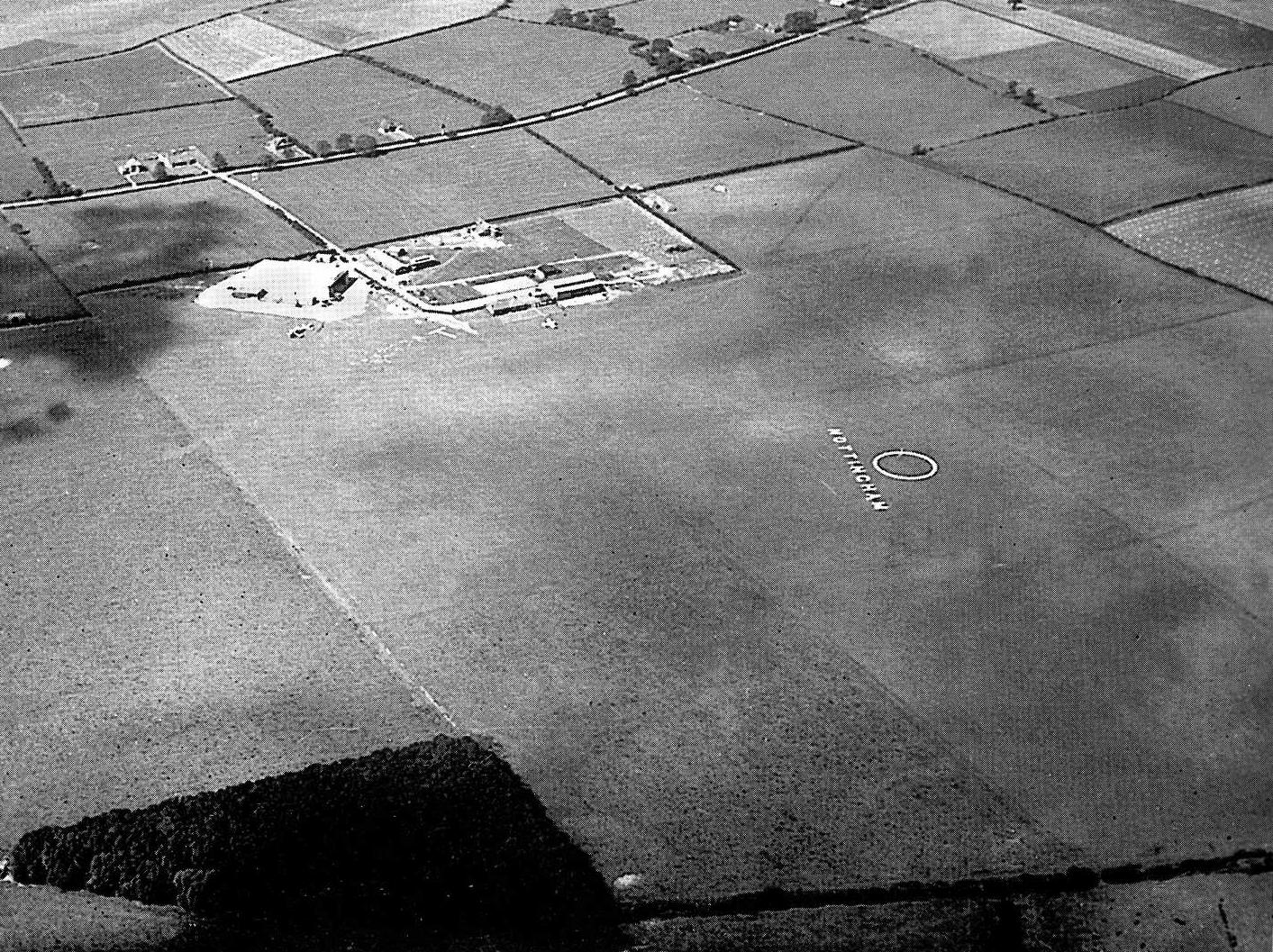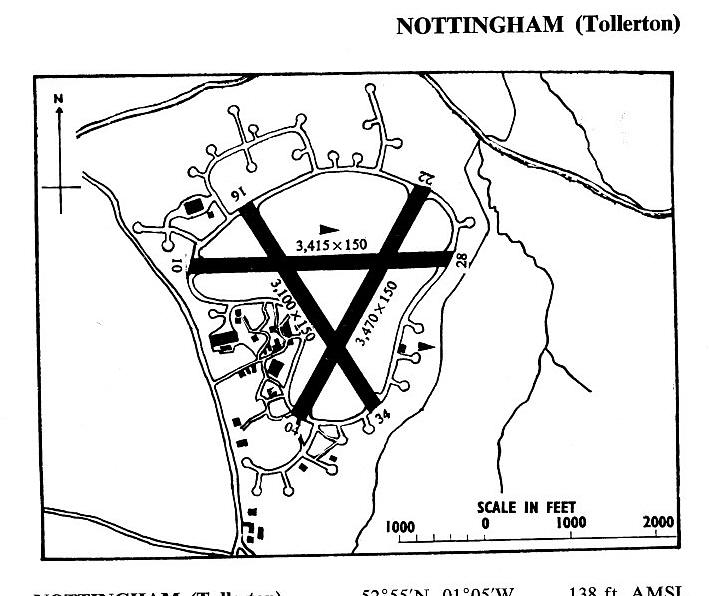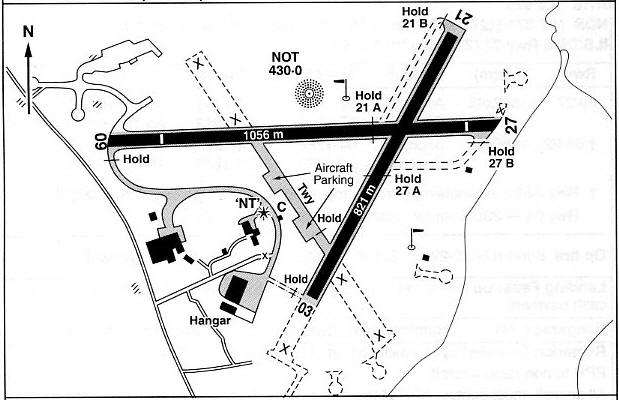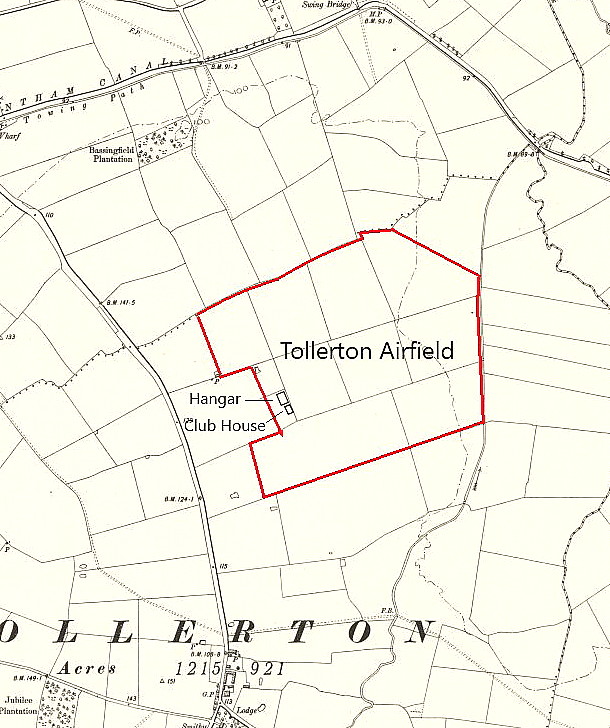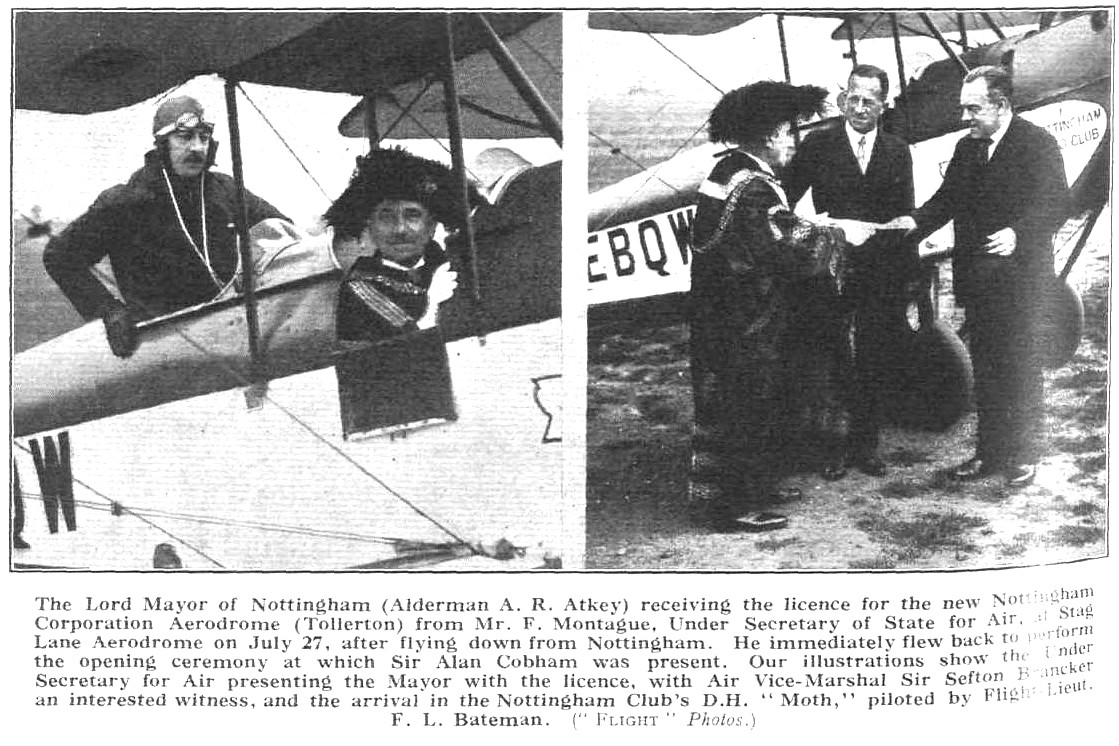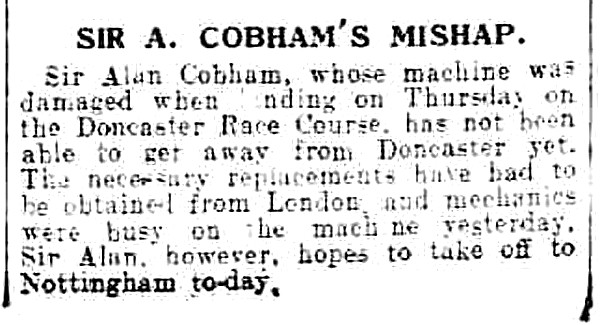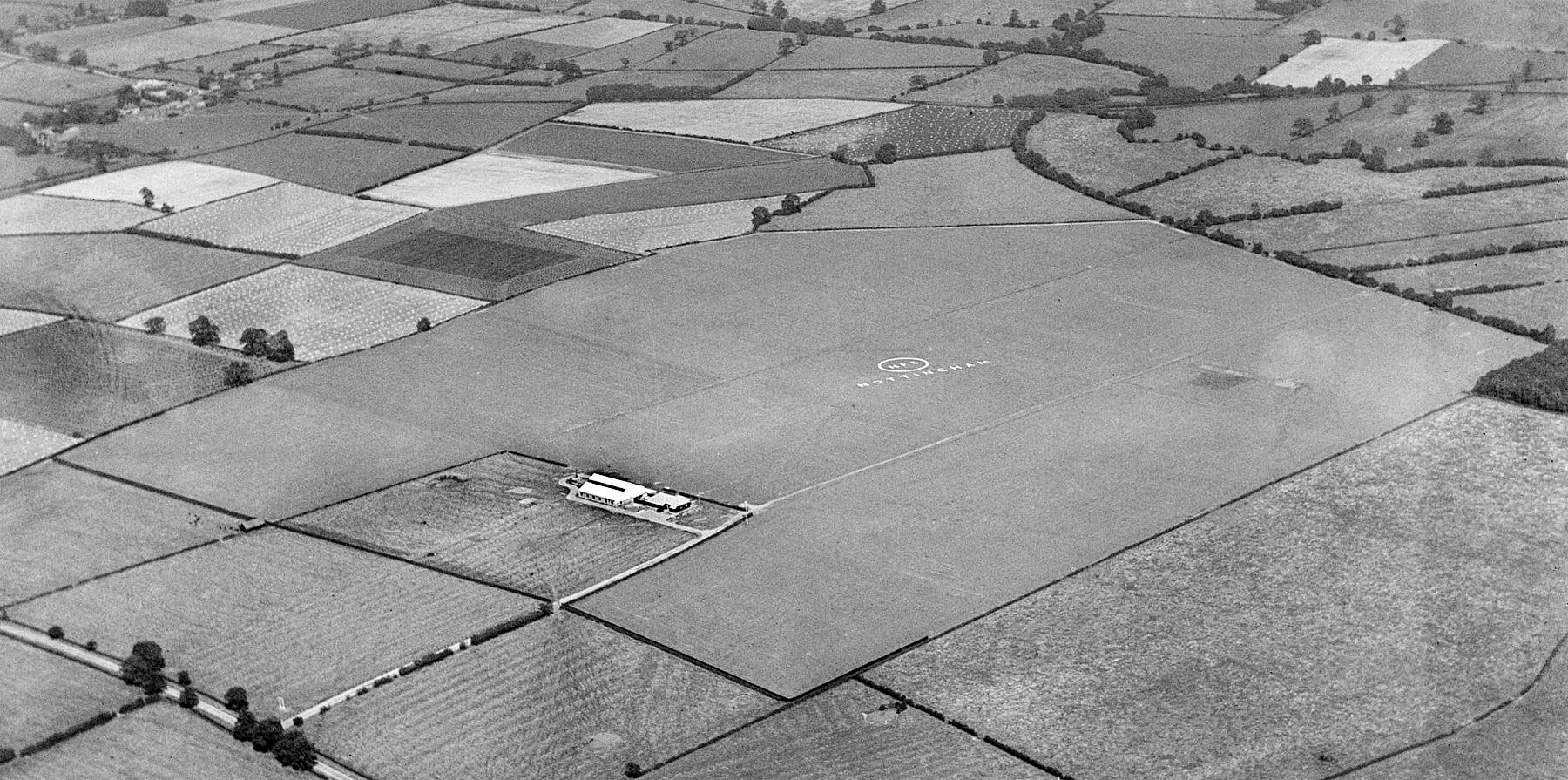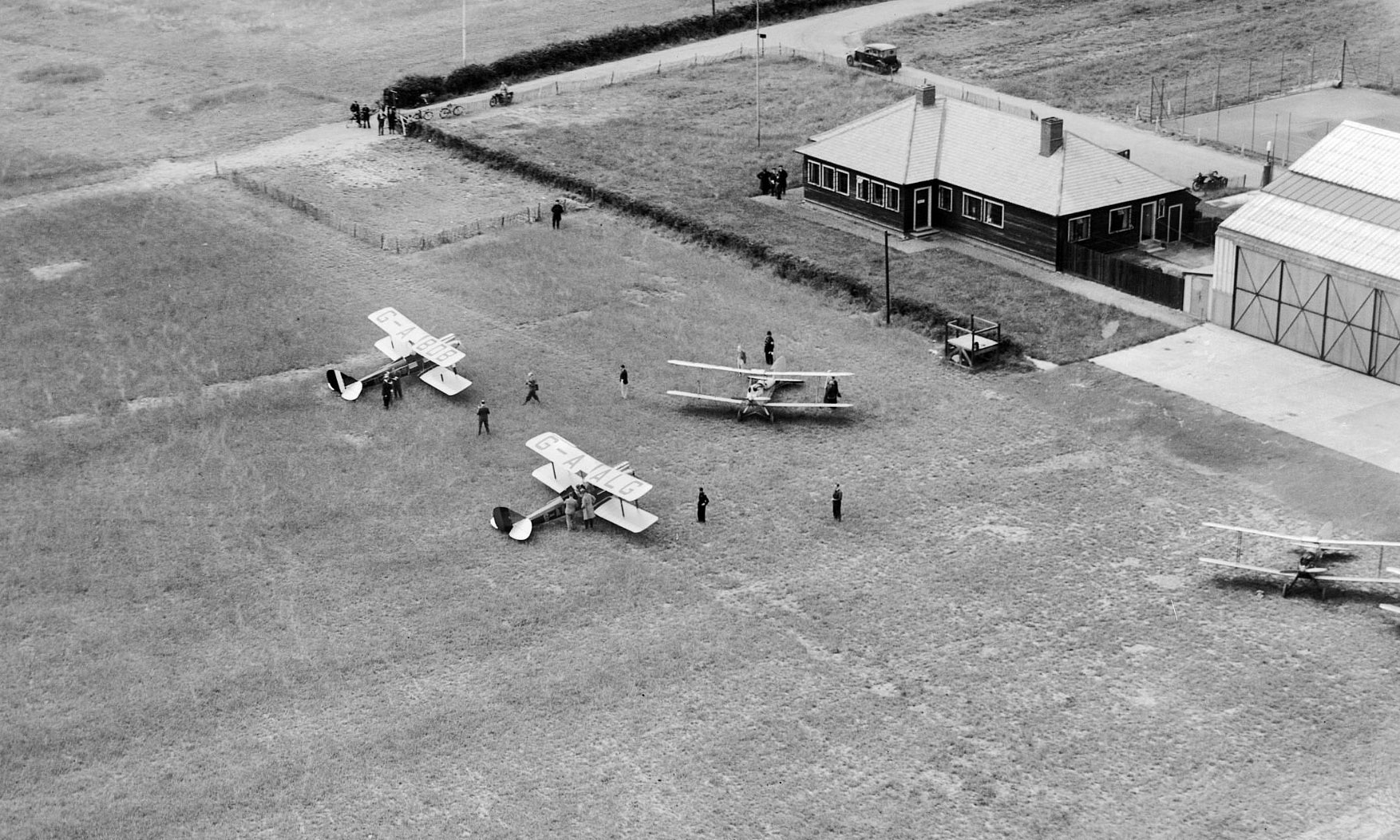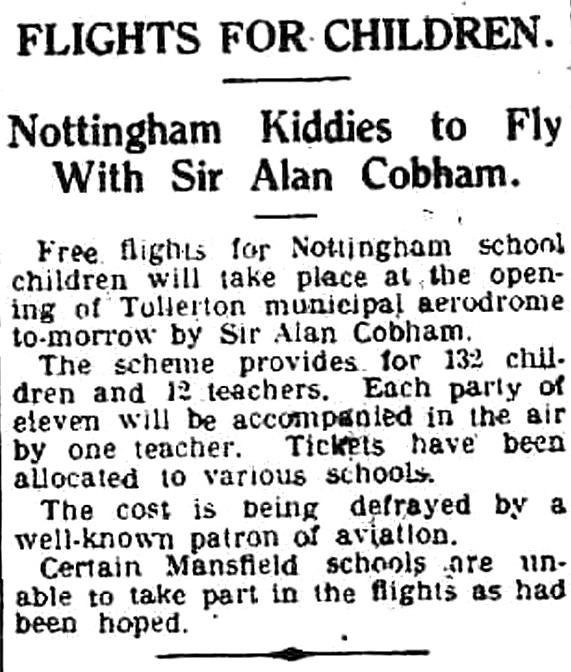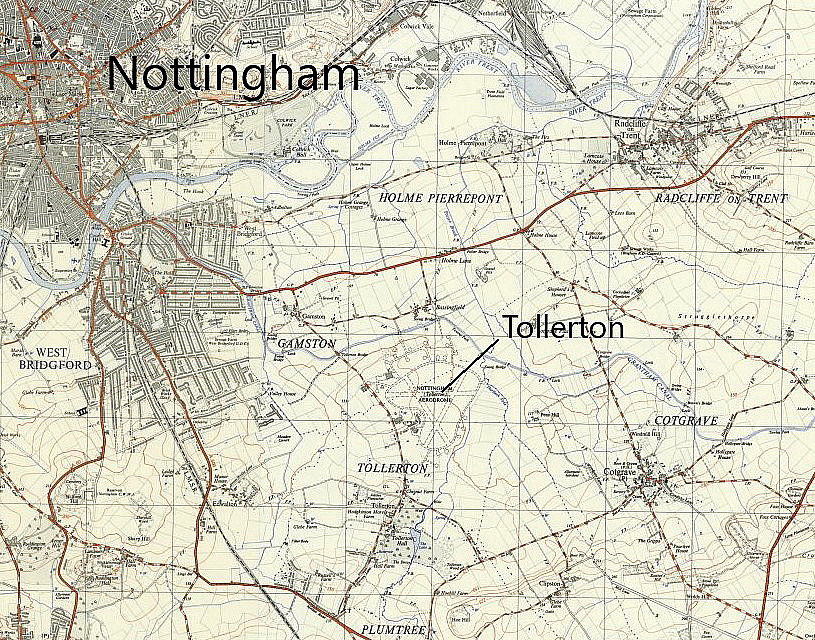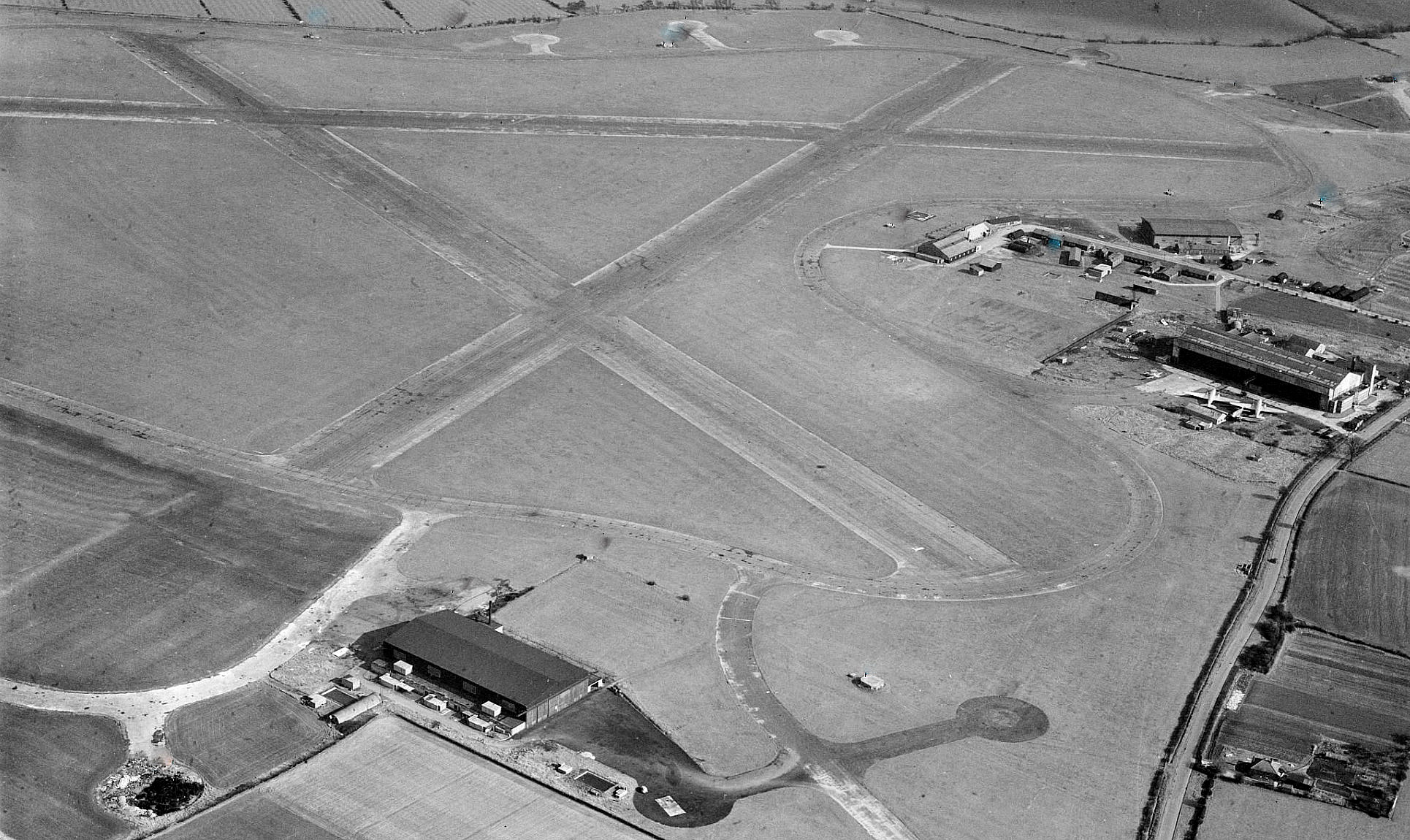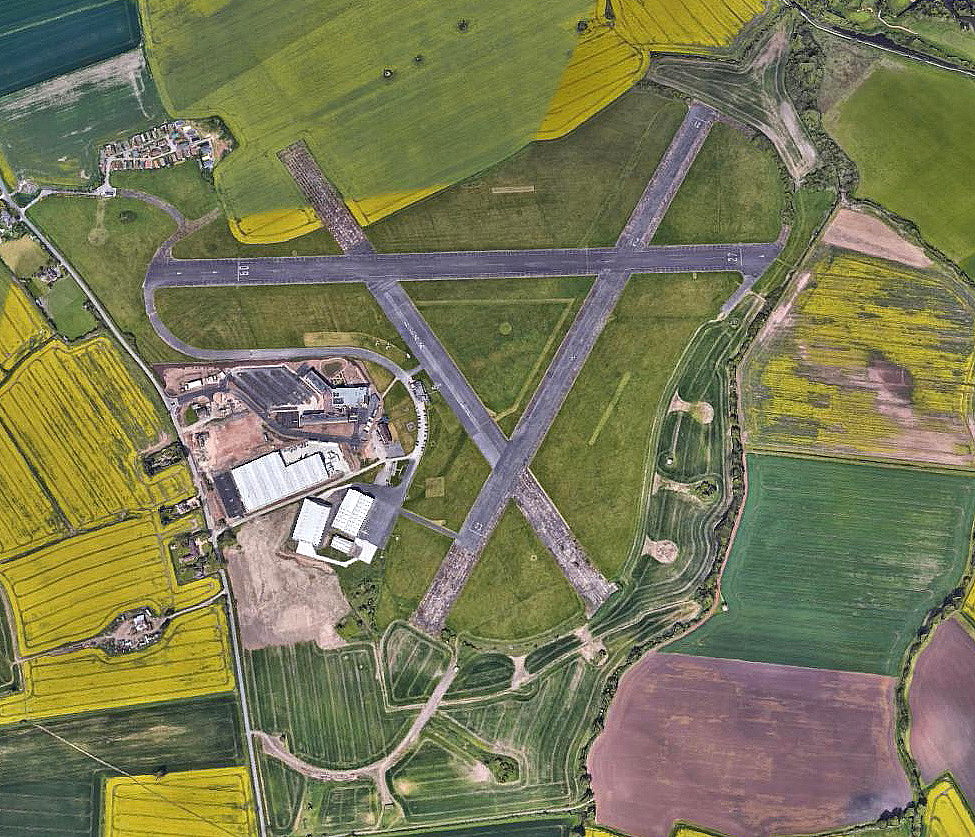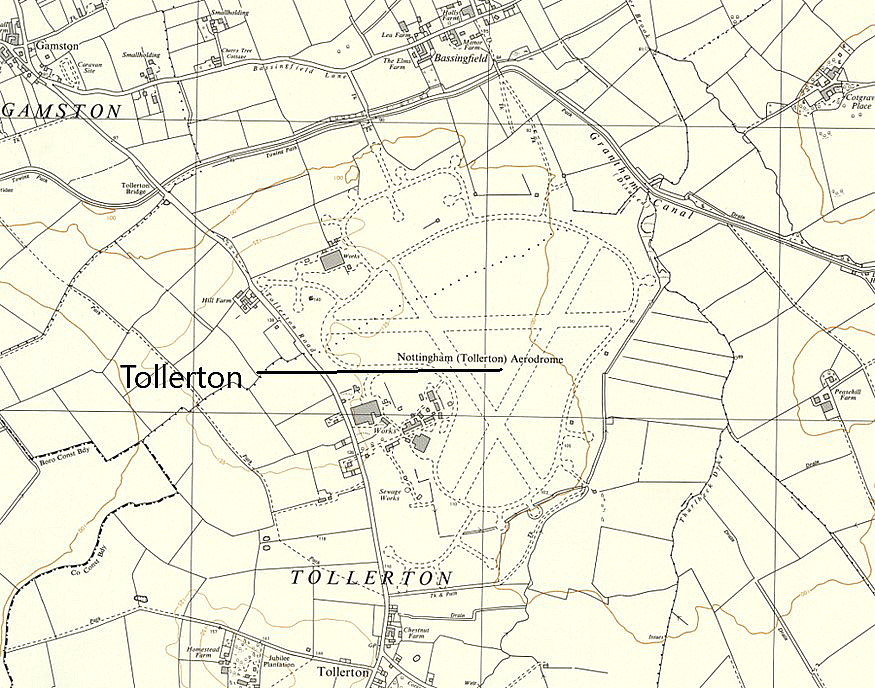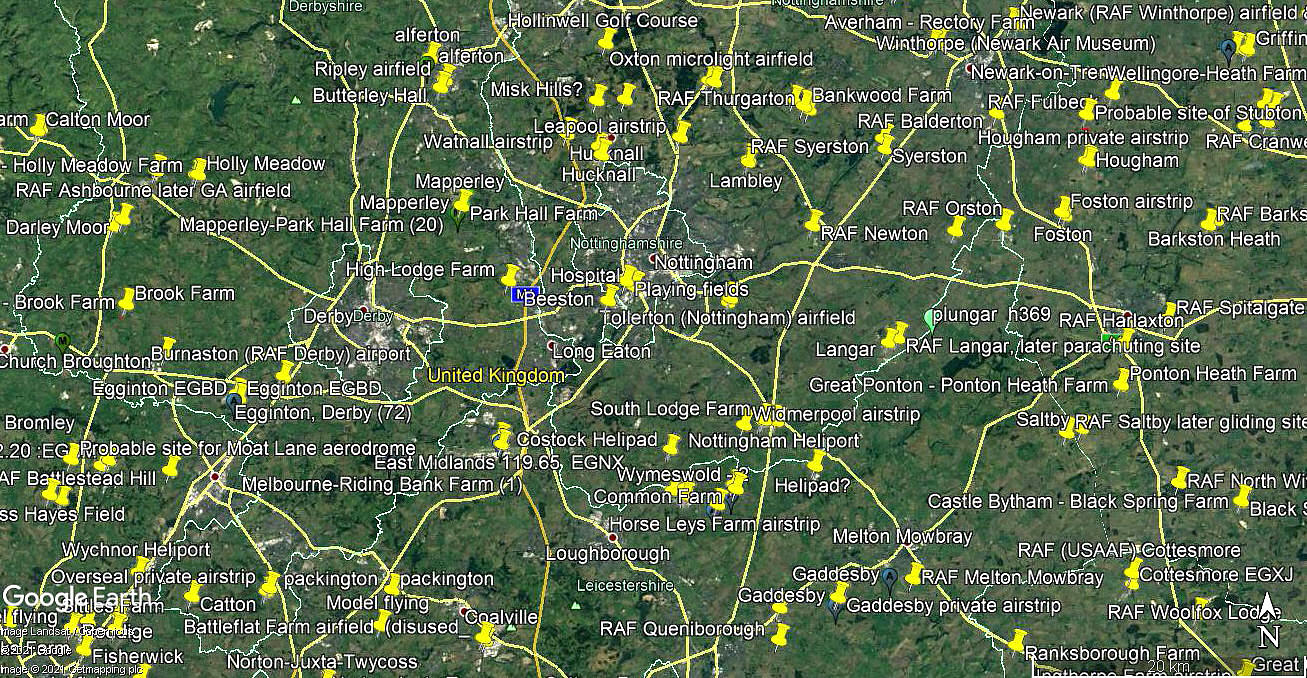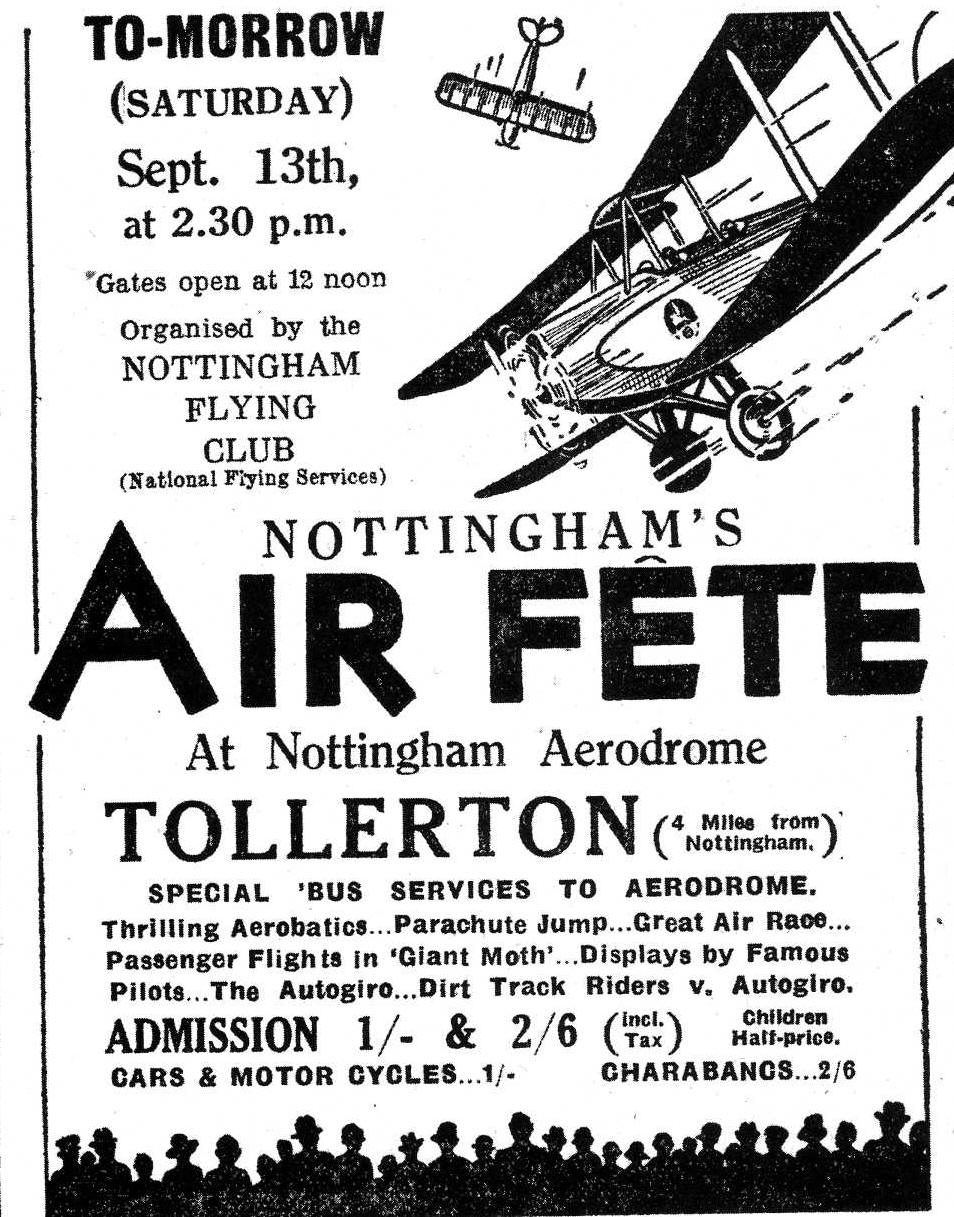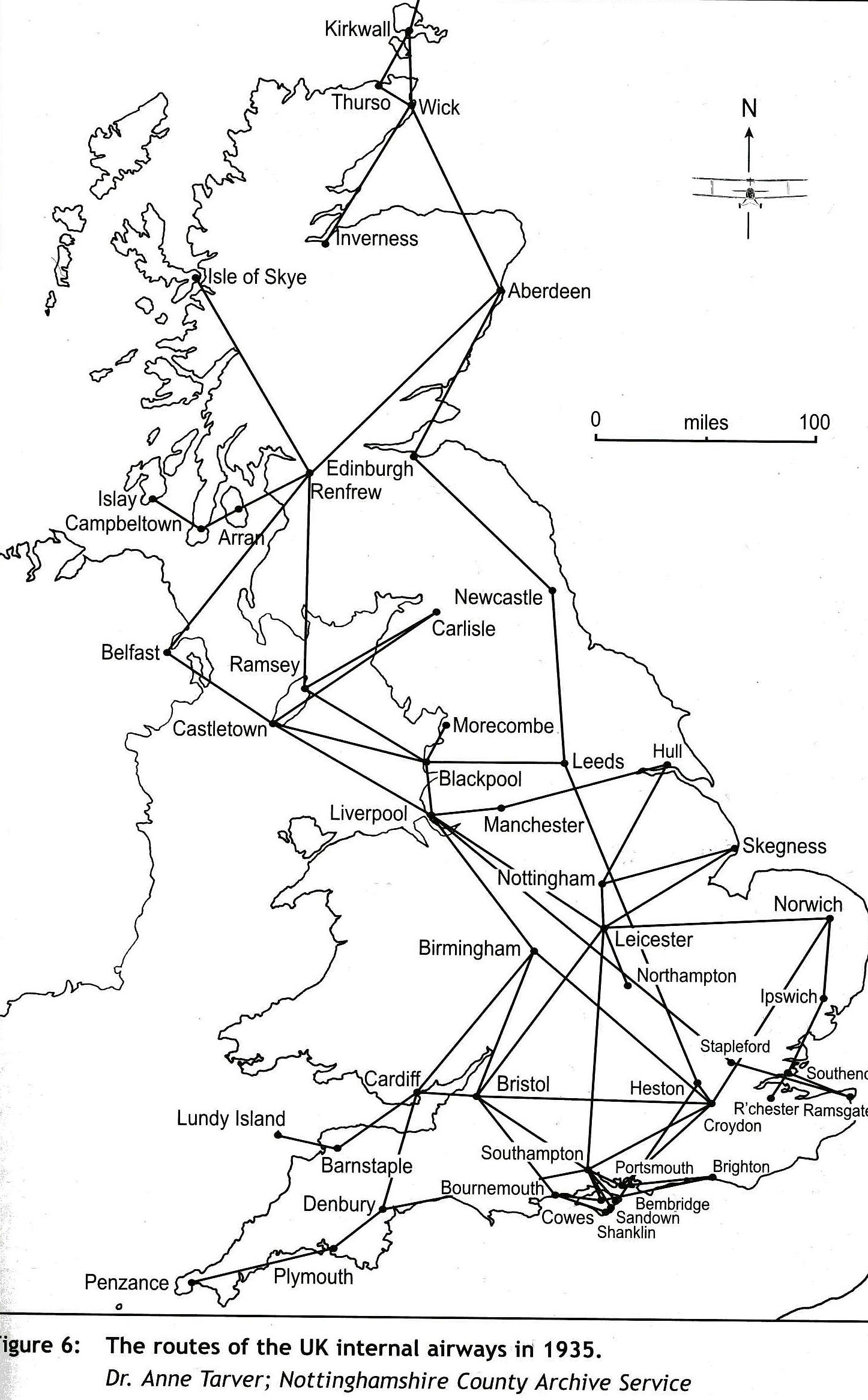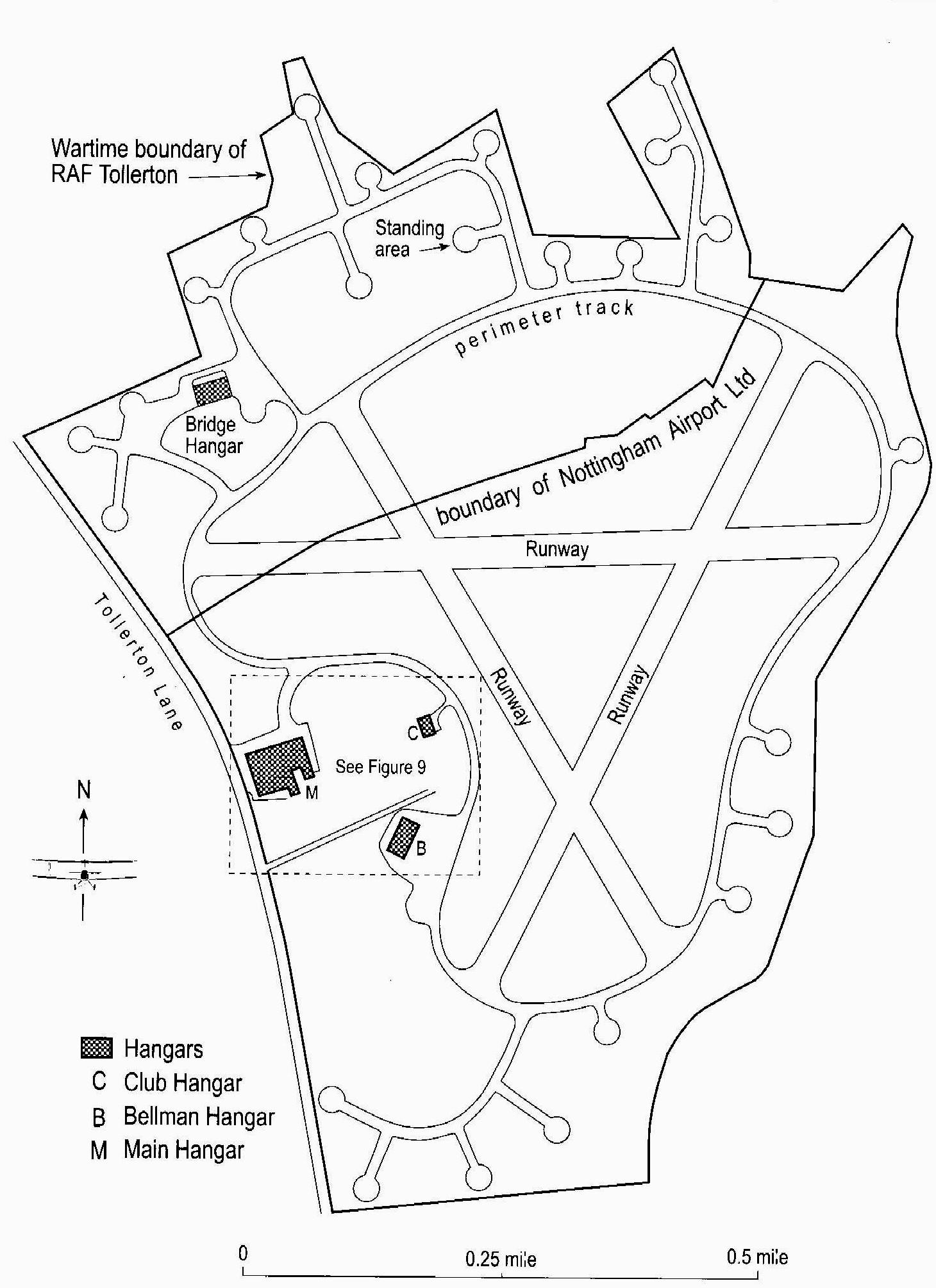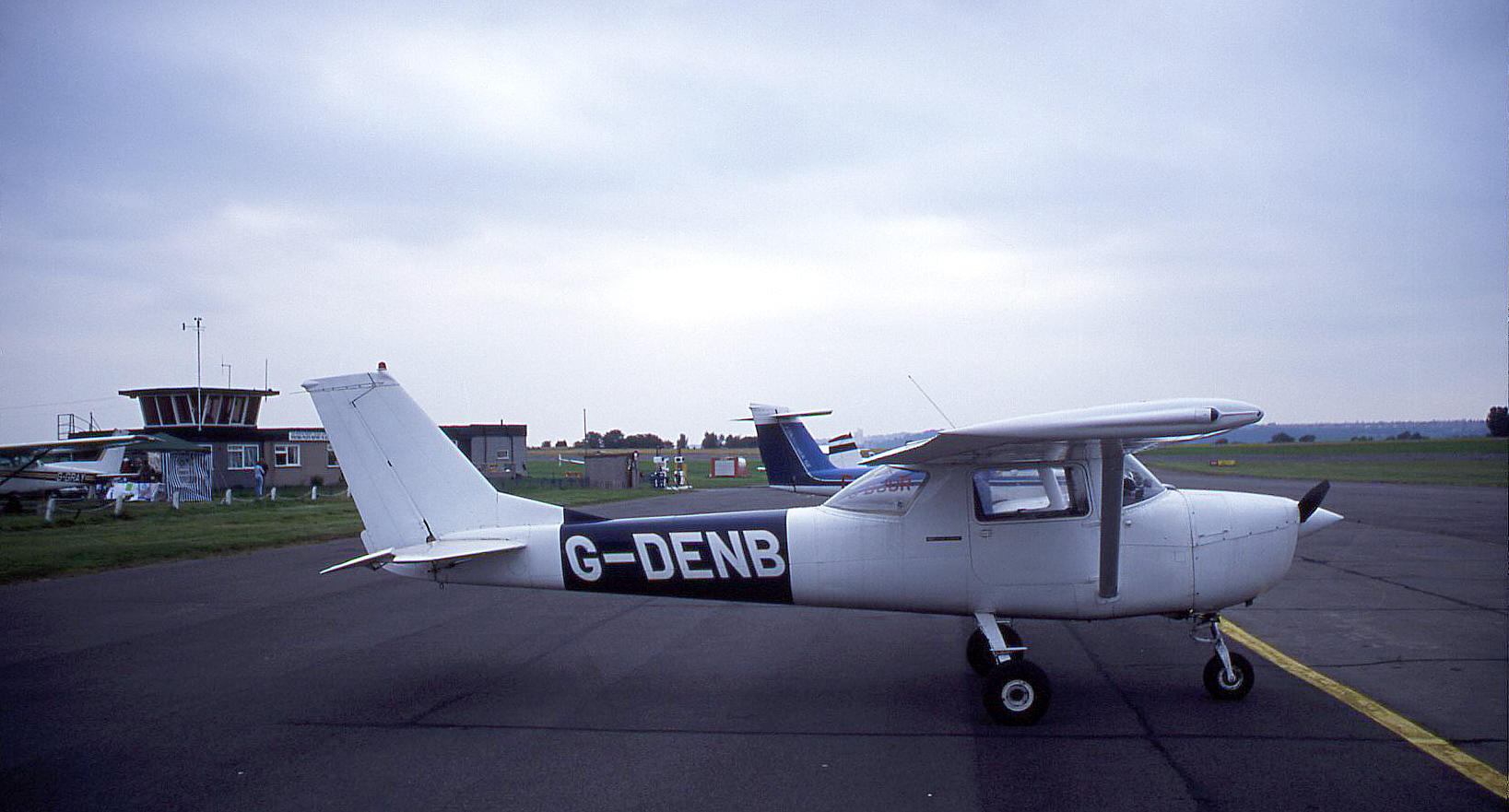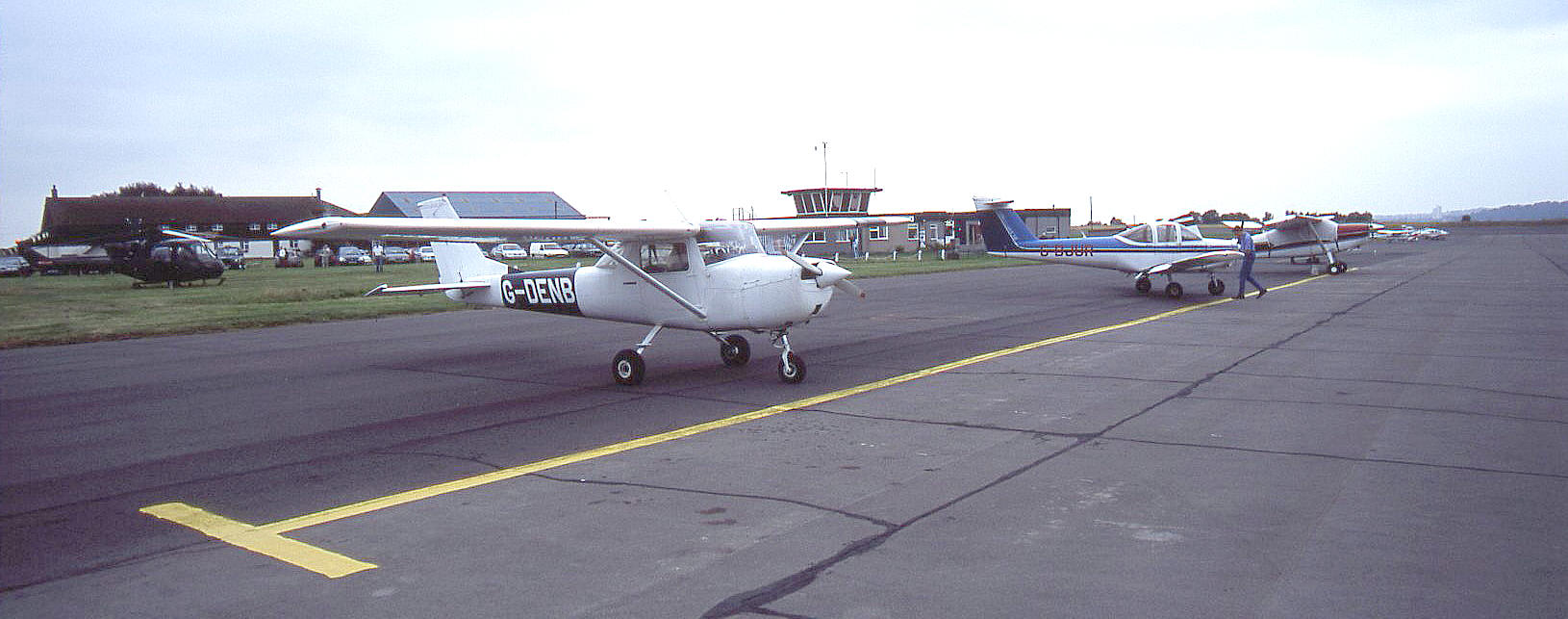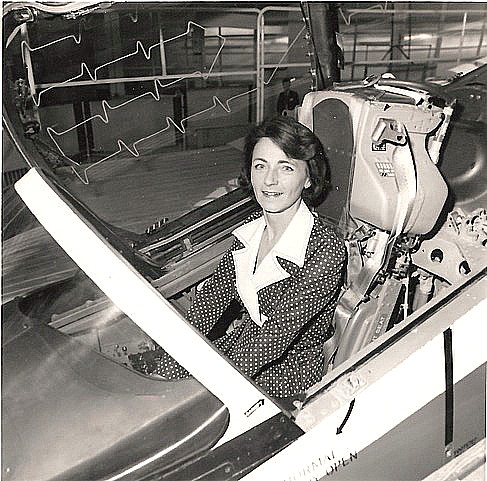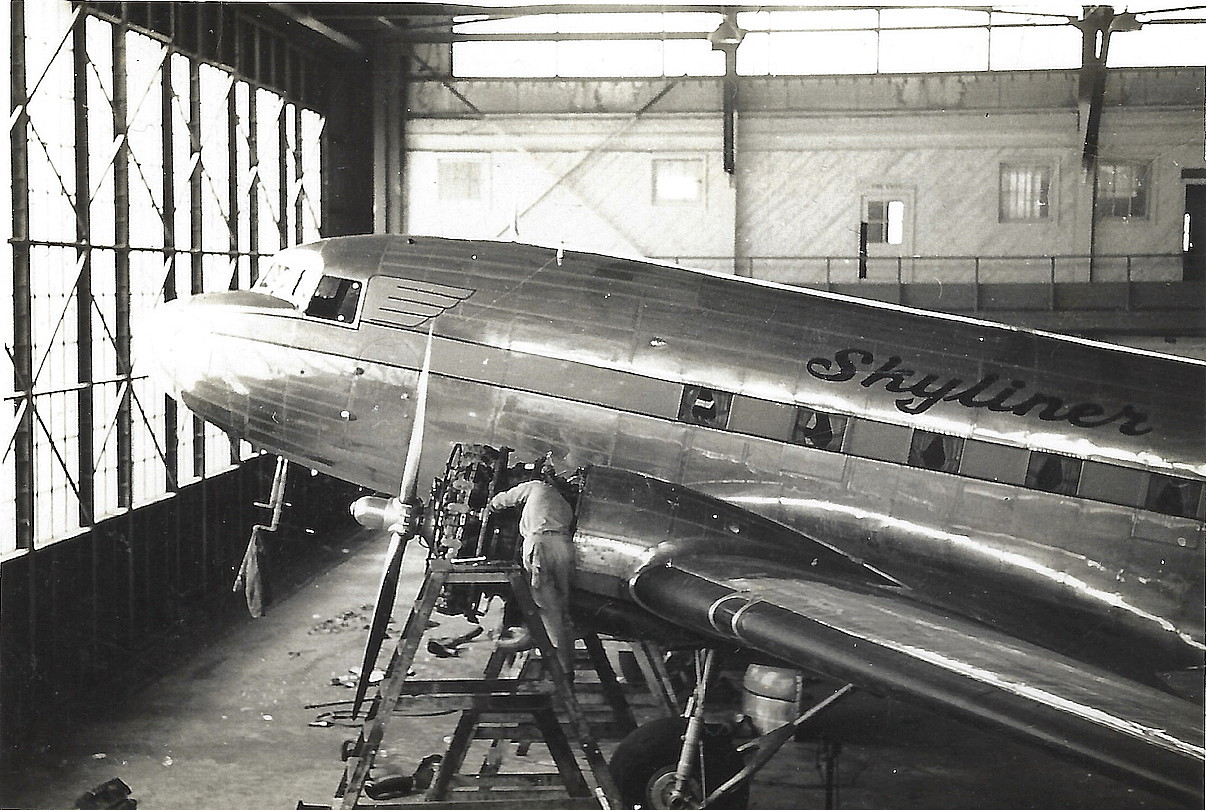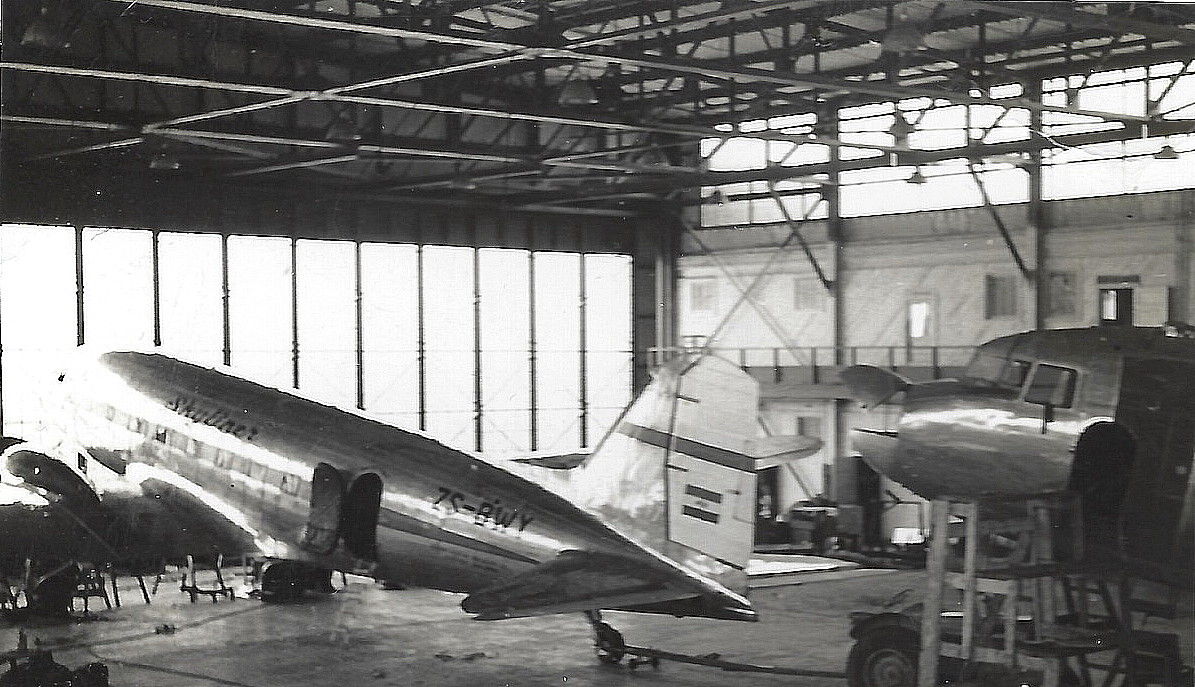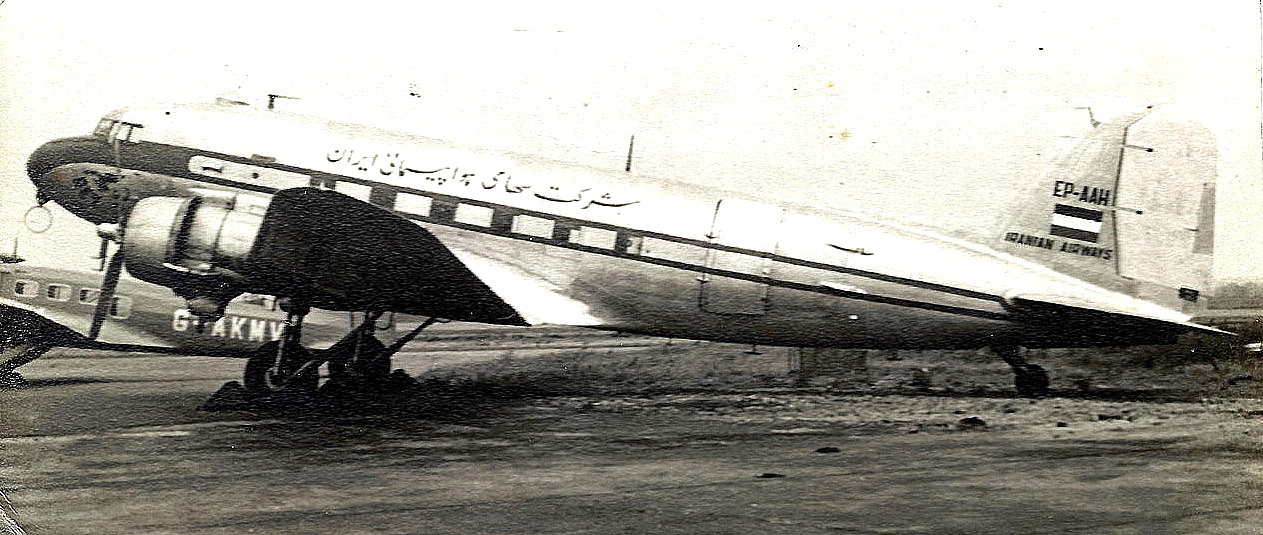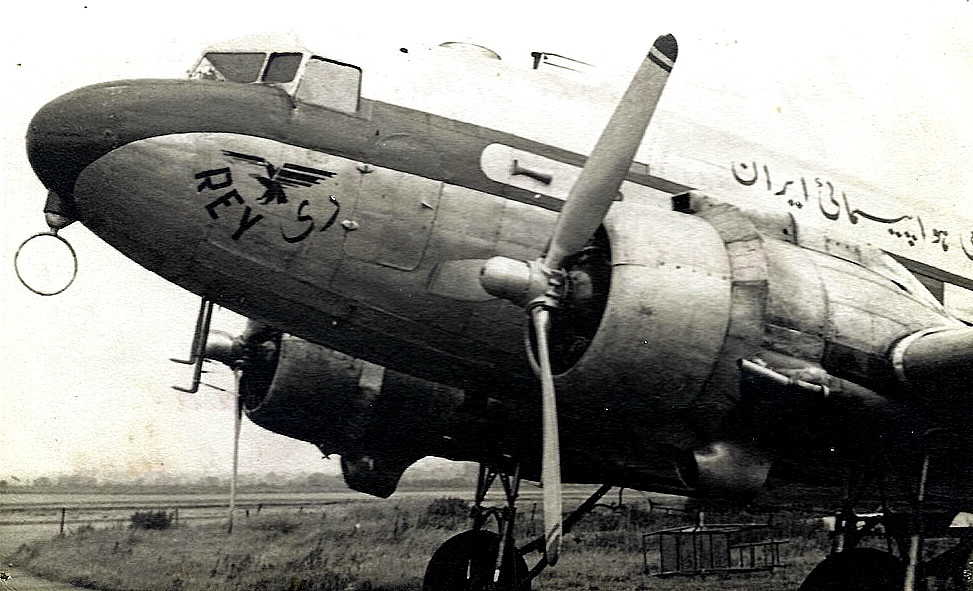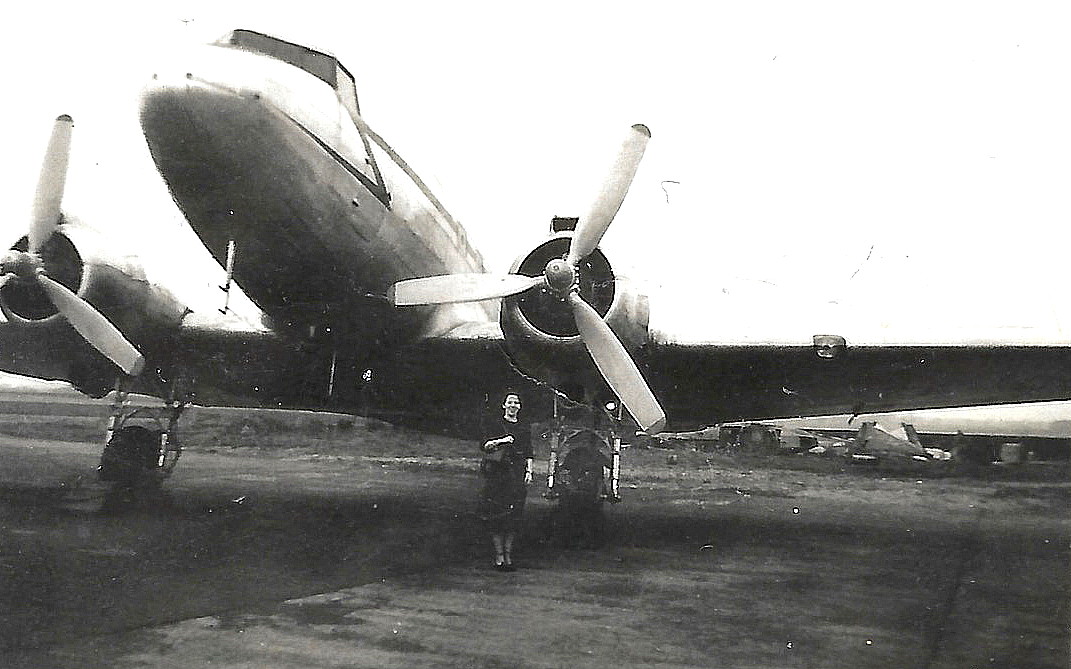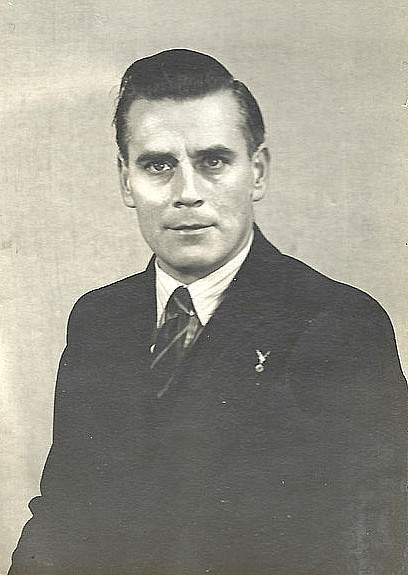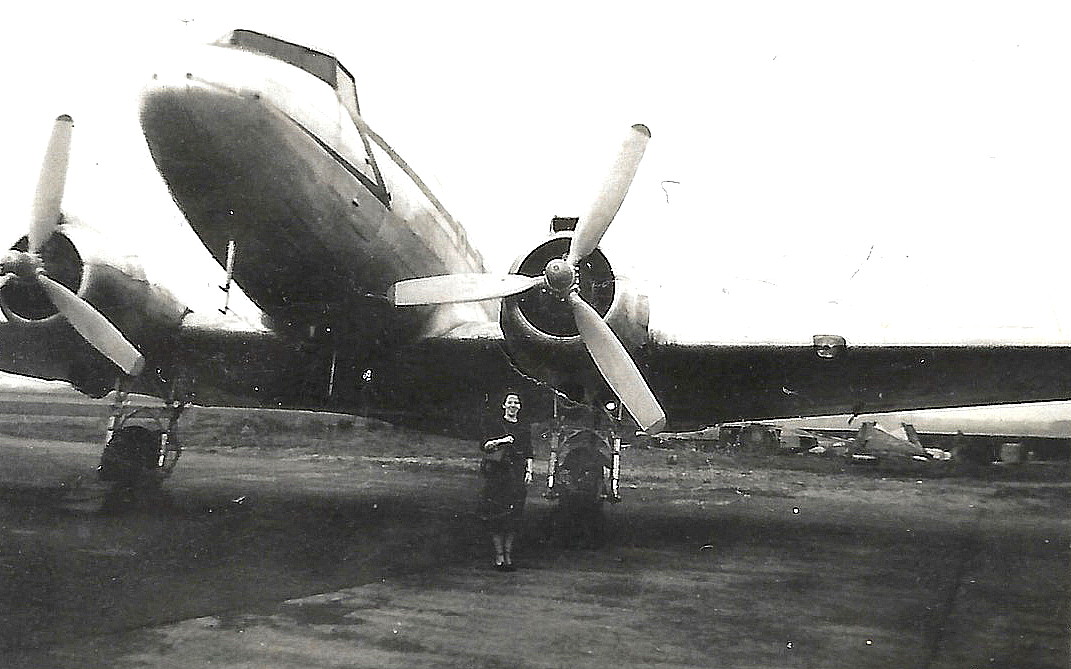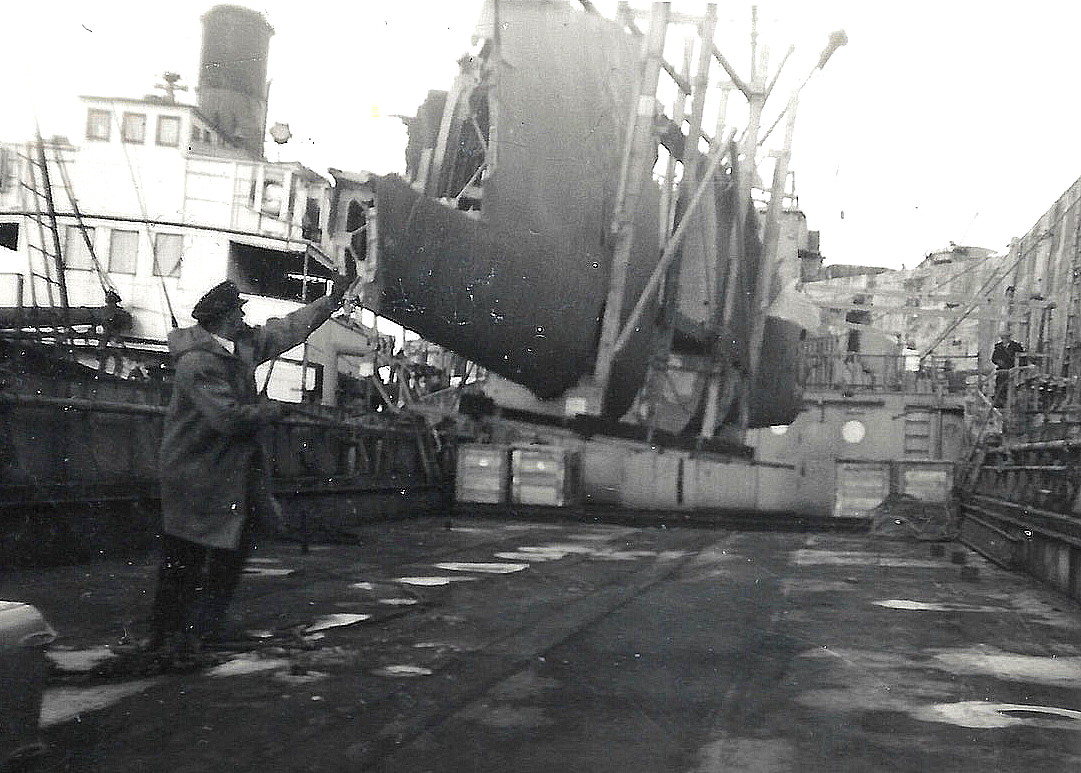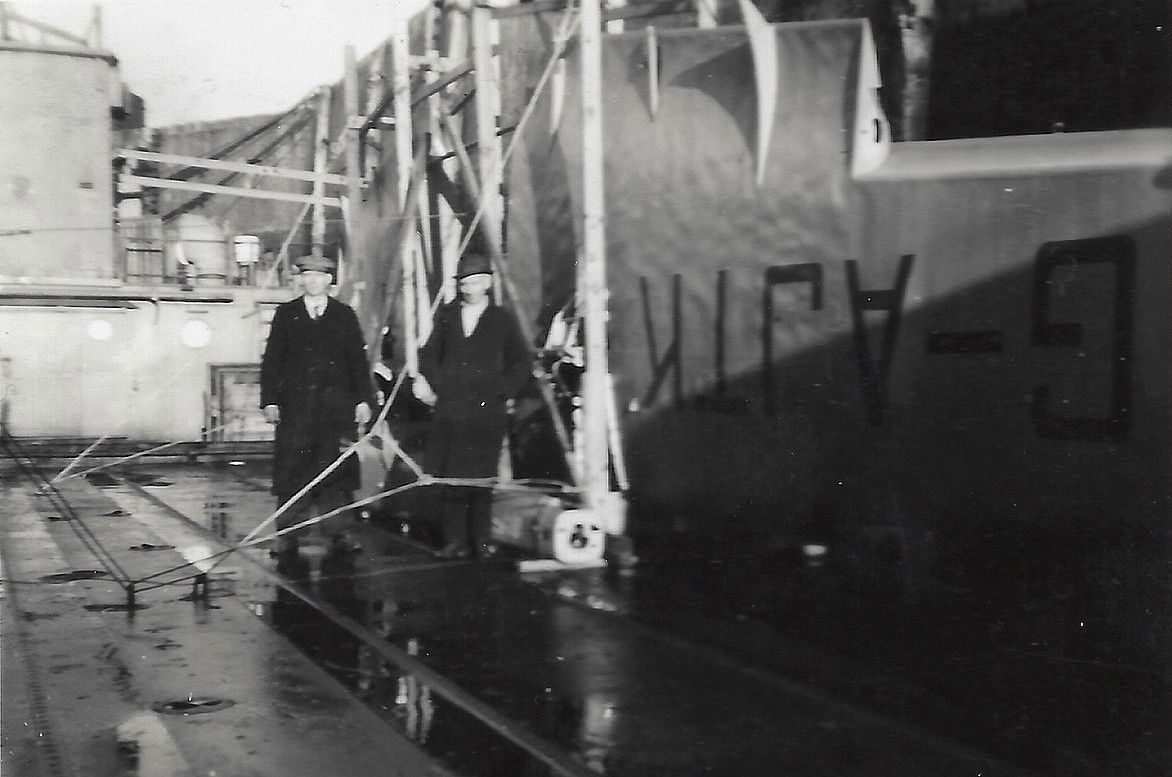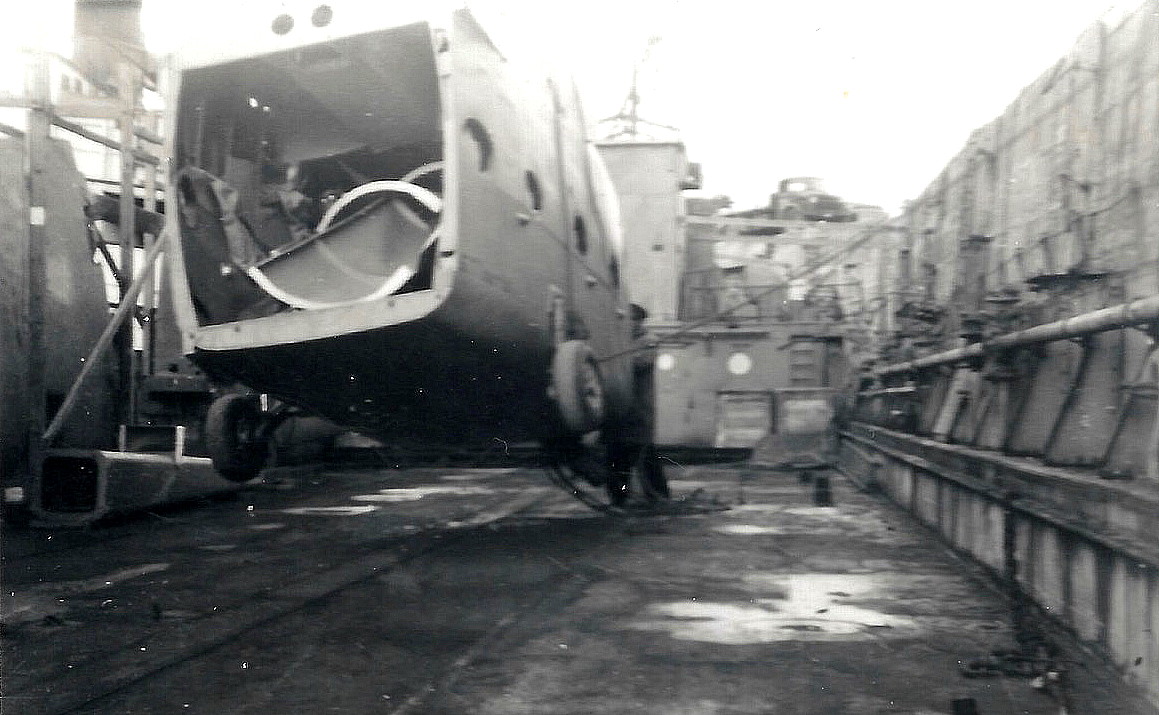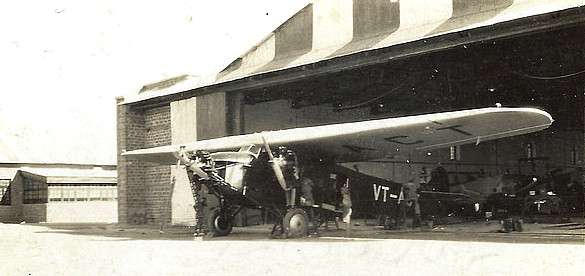Tollerton
TOLLERTON: Military Landing Ground in WW1, later civil regional airport
Originally NOTTINGHAM AERODROME and later NOTTINGHAM AIR PORT
RAF TOLLERTON in WW2
Later still NOTTINGHAM CITY AIRPORT and also NOTTINGHAM TOLLERTON AIRPORT
Military users: WW1: RFC ?Night Landing Ground 38 (Home Defence) Sqdn
Inter-war: RAFVS
27 ERFTS (Miles Magisters & Hawker Harts)
WW2: RAF Flying Training Command 21 Group
27 ERFTS (Avro Ansons, Fairey Battles,Hawker Harts & Miles Magisters)
Bomber Command
44 & 50 Sqdns (Handley Page Hampdens**)
12 Sqdn (Vickers Wellingtons**)
Operated by: 1930: National Flying Services
1934: Nottingham Flying Club
1964 to - : Truman Aviation Ltd
British airline users: Pre 1940: Crilly Airways, Eastern Air Transport, London, Scottish and Provincial Airways, Provincial Airways, Railway Air Services
Post 1945: Derby Aviation, Eagle Aviation (Trent Valley)
Charter/air taxi: Post 1945: Air Transport Association, Blue-Line Airways, British Nederland Air Services, Trent Valley Aviation
Flying club/schools: Pre 1940: Nottingham Flying Club, Tollerton Aero Club
Post 1945: Eagle Aviation, The Sherwood Flying Club, Truman Aviation
1959 ‘snapshot’. Sherwood Flying Club
Later the ‘Player’ Flying Club for employees of the cigarette manufacturer, 1967 to 1970.
In 1974 the Spencer Flying School was established operating two Cessna types, probably a C.150 and C.172?
Another short-lived enterprise was the Pilot Assist College
Helicopter ops: 1974: William Howes of Spondon. Skyline Helicopters & Central Helicopters
Maintenance/repair: WW2; Rollason Aircraft Services
Post 1945: Field Aircraft Services, Harold Hall & Co, Shipside and Truman
Manufacturing: WW2: Tollerton Aircraft Services (Modification work)
Location: E of A52, S of Basingfield, SE of Gamston, 3nm SE of Nottingham
Period of operation: WW1: 1916 only it seems? 1929 to today
(One record says 1930 to 1956 but presumably this was just for military flying activity?)
Note: These maps are reproduced with the kind permission of Pooleys Flight Equipment. Copyright Robert Pooley 2014.
Runways: 1929: Flying area – 99 acres ( In ‘TOLLERTON’ the authors claim, “The aerodrome did not encompass all the land that the Corporation acquired in 1929 and the surplus was let to local farmers.” Therefore the 99 acres claim might well be inaccurate?
1933: Max landing run 823 grass
WW2: 04/22 1023x46 hard 10/28 1048x46 hard 16/34 946x46 hard
1965: 04/22 1058x46 hard 10/28 1041x46 hard 16/34 946x46 hard
1990: 03/21 510x46 hard 09/27 1056x46 hard
2000: 03/21 821x23 hard 09/27 1056x30 hard
NOTES: It certainly does appear that the first recorded use of this site was as a Night Landing Ground by 38 (HD) Squadron in 1916 soon to be replaced by RUDDINGTON.
Much of the information regarding this airfield was gleaned from, TOLLERTON, an airfield for Nottingham. Unusually this book has three authors, Howard Fisher, Bob Hammond and Nigel Morley. I have decided to quote extensively from this book, not least because it was an opportunity to provide another rather in-depth account for this region of the Midlands. To preserve space, and the readers patience, when quoting I shall simply use ‘TOLLERTON’.
A MICHAEL T HOLDER GALLERY
Notes: Regarding the second item, the Lord Mayor of Nottingham, Alderman Atkey, was flown down to STAG LANE (LONDON) on the 27th July 1929, in the de Havilland DH60 Moth, G-EBQW, to collect the licence to operate the aerodrome. Clock the headgear! Presumably he didn't try to keep wearing this after the engine was started?
Just a quick comment, when the civil aircraft register was started after WW1, the 'G-E' registrations included the letter 'Q'. This letter was dropped when the new register, commencing G-AAAA, was introduced in 1928.
As was quite typical in those days, the official opening did not take place for some time afterwards. The newspaper piece, (third item), was published in the Sheffield Independent on the 27th July 1929.
Note:The fifth item above, was an article published in the Derby Daily Telegraph on the 29th July 1929 and seems to indicate that Derby was rather concerned about Nottingham 'stealing the march' in regards to aviation.
The two aircraft that can be indentified in the sixth item above are: G-AALG, a de Havilland DH60M Moth, (registered 05.09.29), and G-ABOB a Spartan Arrow, (re gistered 28.07.31), so brand spanking new!
The seventh item, 'Flights for Children', was published in the Nottingham Journal on the 26th July 1929. This is interesting in as much as Cobham generally flew either forty or fifty at each venue. The anonymous donor who paid for these flights, we now know, was Lord Wakefield of Castrol Oil fame.
We are very fortunate to have so many kind and generous people contributing to the 'Guide', and the gallery above from Mike Holder is a great example, which certainly helps to illustrate many aspects of the history of TOLLERTON listed in text below. Do please remember that the 'Notes' are all mine, but hopefully without any errors?
A NEW BEGINNING
After World War One nothing seems to have happened here in aviation terms until Sir Sefton Branker ‘officially’opened this aerodrome in June 1930*, (although it’s original 142 acres, purchased by the City of Nottingham had been cleaned, levelled, rolled and seeded in 1928). The license to operate the aerodrome was granted in 1929. From ‘TOLLERTON’; the site covered “141.359 acres in a block extending from the eastern side of the Nottingham to Tollerton road, as far as the Polser (or Poulter) Brook and the Tollerton and Holme Pierrepont parish boundaries.”
*Typically this date certainly appears to be incorrect and I think it is well worth quoting in full, the account of the opening day told in ‘TOLLERTON’ especially to illustrate the amount of civic pride felt in those days when an aerodrome/air port was opened. “The opening date for Tollerton was set for Saturday 27 July 1929 and it had been arranged that the famous aviator, Sir Alan Cobham, would land his DH Grand Moth aircraft, named ‘Youth of Britain’, at Tollerton in which he would then fly the Lord Major to London where he would be presented with the Air Ministry’s license for Tollerton to be used for aviation. (My note:Cobham's aircraft was actually the DH.61 Giant Moth G-AAEV). The plan was that the Lord Major would return to Tollerton to officially open the aerodrome. There would then be a civic reception and later in the afternoon Cobham would give some of the dignitaries a flight and then a flight for some school children selected by the City’s Director of Education. The cost of the children’s flights was said to have been covered by an anonymous donor who was, in fact, Lord Wakefield who was a strong supporter of aviation. After the children’s flights, Cobham was to give pleasure-flights to the general public.”
“In the event, Cobham was unable to fulfil the first part of these arrangements due to his aeroplane having been damaged at Doncaster on the day before the official opening. Parts were urgently flown from Stag Lane, London, but the repairs were not completed in time.” I loved this account in 'TOLLERTON', not least because Alderman Atkey is shown in a photograph as being severly ‘vertically challenged’ but very obviously a very plucky chap to say the least. “Alderman Atkey, wearing his ceremonial robes as Lord Mayor, was therefore flown to London by Flight Lieutentant R. Lee Bateman, the Flying Instructor of the Nottingham Aero Club, in the Club’s DH60 Moth, G-EBQW. This was an open-cockpit aircraft and therefore much less comfortable than Cobham’s Grand Moth cabin aeroplane would have been.”
Perhaps it is just me, heavily influenced by Monty Python in my more formative years, but the vision of a Lord Mayor, in all his finery, emerging from a Moth at STAG LANE seems both utterly bizarre and equally comic. Alderman Atkey - I salute you. Please find a copy of this excellent book to see the picture on page 10 - and clock the garb and especially the hat! How anybody could keep a straight face wearing that clobber escapes me.
AN AUSPICIOUS OCCASSION
The account then has this interesting information; “Leaving Hucknall aerodrome at 8 a.m. (My note -why not TOLLERTON?) on 27 July the aircraft reached Stag Lane aerodrome at Edgware, London, thirty-five minutes before the scheduled arrival of 10 a.m. In order to kill time Flight Lieutenant Bateman flew over London, returning to Stag Lane for 10 a.m. where Air Vice-Marshall Sir Sefton Brancker and the Under-Secretary of State for Air, F. Montague MP, were waiting to present Tollerton’s license to Alderman Atkey.”
What an auspicious occasion that must have been, lasting at best, fifteen minutes. It seems to me to being akin to, in top official circles, “There’s your certificate sunshine, now piss off.” So, “…to avoid reaching Tollerton before the official opening time of 12.30 p.m., the Lord Mayor was given a tour of the de Havilland factory. What the de Haviland workers thought of the diminutive Alderman Atkey in all his finery is not recorded. The aircraft still arrived back in Nottingham early and had to fly over the City for a short while before landing at Tollerton at the appointed time.”
“The aerodrome was declared officially open, the license handed to the Town Clerk for safe keeping and the party of dignitaries given an official luncheon at Tollerton Hall which had recently opened as a Country Club. Sir Alan Cobham flew from Doncaster in a Moth to attend the luncheon and then immediately returned to Doncaster to collect the by then repaired ‘Youth of Britain’ so that he could, at least, fulfil that part of the original arrangements to provide flights for the school children and public. Whilst awaiting the arrival of Cobham, free flights were provided in the two Moths owned by Nottingham Flying Club, (My note - they said this was Nottingham Aero Club), and Flight Lieutenant Bateman provided a display of stunt flying.”
Apart from being picky over a couple of details, I do believe this account is roughly typical of many similar openings of British aerodromes/air ports during this period. There was nothing there worth mentioning in terms of infrastructure, possibly a windsock, just an open space prepared for aircraft to land on. Probably difficult today to realise just how important such a minimal facilty was perceived in those days. “Cobham arrived at 5 p.m., the dignitaries were flown over the City, the children given their flights and the public then bought flights until it was almost dark. The following day flights were available from 11 a.m. lasting until dusk.” We really must remember that for the vast majority of people, getting just a single flight in those days, was, in terms of import to their lives, not too far short of getting a place on a machine going into space today. I exaggerate for effect of course, but, in some parts of the UK many people stiull hadn't seen an aircraft, let alone one flying.
A 'HAND'S ON' ACCOUNT
In ‘TOLLERTON’ the authors give an account of a reporter from the Nottingham Journal who took a flight. “The trip was a glorious adventure which should certainly be experienced by everyone. Not only was the flight extremely exhilarating, but it afforded one an unusual, though very excellent view of Nottingham and its surroundings, a view which could not possibly be obtained in any other way and indeed would not have been dreamed of a few years ago. Practically everyone seemed surprised when they stepped into a large, roomy cabin to be seated in a luxurious armchair. The comfort of the giant machine was most impressive.” This "giant machine" was almost certainly Cobham's DH.61 Giant Moth G-AAEV which could seat eight passengers.
Contrast this to the majority of people, (99%?), who fly on commercial flights today. Even if given a window seat few take much interest. They are utterly bored by the fact they are being subjected to one of the most incredible experiences most human beings can be exposed to. Which in turn raises so many questions regarding spotting situational awareness and any overt signs of intelligence appearing in the general population? I'm sorry, I do get carried away.
AIR MINISTRY ADVICE
‘TOLLERTON’ also contains this very interesting and very sensible information and advice - can you even imagine the reaction to these today? “An Air Ministry pamphlet of June 1929 entitled How To Establish An Aerodrome set out the expected requirements. Tollerton eventually complied with most of these which included the need for aerodromes to be as close to town centres as possible and to be on the side of a town where the prevailing wind would blow smoke and dust away from the airfield. It was recommended that the site should not be close to a river for fear of frequent fogs and a situation on a plateau, providing it was not too high, was to be preferred. There should be no high obstacles such as chimneys or church spires close by, nor should it be at the foot of or near a hill. A telephone at the site was essential as was water and light.” A history lesson about the realities of life in the 1920s and 30s could be based on many of these few words alone and it does of course illustrate that the legacy of the industrial revolution was still very much in evidence. It also goes to illustrate that the siting of one the most important regional airports, CASTLE BROMWICH, ENE of Birmingham, flies, (excuse the pun), in the face of nearly all these recommendations! Begging the question, was anybody actually in charge?
I have brought attention to this aspect of aerodrome licensing elsewhere, but reckon it is well worth repeating here. “….it is amusing to read of the recommended way of assessing the surface for smoothness and its suitability to handle the weight of an aircraft. In the former case it was said that a car had to be capable of being driven across the ground at 20 mph without inconveniencing its passengers. For the weight-bearing capabilities if a fully laden 3 ton lorry could be driven across the land without its wheels sinking, the weight of an aircrafts wheels and tail skid could be sustained.”
KEY PEOPLE
What I think is of note, particularly evident with this ‘Air Port’ site, is the realisation it came into being due to a few key figures with considerable foresight and determination, only to be defeated in the end, by the ‘English Disease’. Petty officials with ample qualifications but no ‘education’ - and definitely no imagination or vision. What needs to be remembered is that the time lapse between a licence to operate being awarded, and an official opening could be up to a year or more!
What appears significant is the fact that; “Tollerton was the second municipal aerodrome in the UK to receive an operating license and the first with a permanent site.” After the ‘Grand Opening’ in 1929 it all went downhill bit by bit. The sad fact is that the initial enthusiasm was misplaced, and in many ways the sceptism of the minor officials proved to be correct in the long run, but for entirely the wrong reasons. The viability and apparent success of ‘Municipal owned Air Ports’ such as DONCASTER and LEICESTER didn’t stand the test of time.
The original arguments for establishing and expanding TOLLERTON, (and DONCASTER and LEICESTER), as a major regional airports would still hold good if it wasn’t for the massive increase in population demanding ever more space to build housing and commercial sites providing employment. ‘Air Ports’ near to city centres was a doomed concept at pretty much the same time the idea was being mooted. But, this is just one aspect. The really BIG problem in trying to explain why some, if not most of the ‘Air Ports’ we now have in the UK today exist, depends upon such a complexity of issues at each and every site, they are almost impossible to unravel. Indeed, a subject probably worthy of a University Degree second to none if the full story could be told , which is of course is impossible. And this applies to all accounts of history, needless to say.
History was so much simpler when I was at school.
DECISIONS HAD TO MADE
One reason I think the history of TOLLERTON is worth dwelling on is due the efforts made by the authors of ‘TOLLERTON’ to explain how the 'Air Port' survived. For example; “After the aerodrome was opened decisions still had to made by the City Council regarding the infrastructure. They had an aerodrome without buildings.” What in those days constituted an ‘Air Port’ needs some clarification, but it would imply the existence of Customs facilities, which were applied for in the case of TOLLERTON (Or NOTTINGHAM AIR PORT).
Rather than exert control over the site Nottingham City Council decided to lease the site to a commercial concern, NFS (National Flying Services Ltd), based at HANWORTH (LONDON AIR PARK) with a raft of ‘big names’ involved, including - Captain the Honourable F. R. Guest, Lieutenant Colonel A.A.E. Edwards, Colonel the Master of Semphill and Sir Alan Cobham. As per usual the ‘Toffs’ were very good at ‘talking the talk’ and arranging a splendid official ‘Opening’ which occurred on Thursday 19 June 1930. It appears NFS failed in 1933 and in March 1934 ‘Nottingham Airport Ltd’ was formed, run by North Eastern Aviation.
AN AIR TAXI SERVICE
This concept for the wealthy, and/or big commercial or industrial concerns, is without much doubt the beginnings of what today is the executive jet and helicopter business. In ‘TOLLERTON’ the authors provide information regarding the Air Taxi Service offered by NFS in 1930, available from the seven aerodromes they operated and any of the fifty five aircraft they operated were available. The cost of a single passenger open-cockpit air-taxi was one shilling per mile, a DH Moth or Blackburn Bluebird for example. It was one shilling and sixpence for a Desoutter. Amongst the fifty-five aircraft NFS operated was at least one eight-seater ‘airliner’, a DH84 Dragon. I reckon this episode is worth mentioning; “An attempt to publicise the air-taxi service was made at the September 1930 Tollerton air pageant. An NFS owned de Havilland eight-seat air liner flew from the NFS headquarters at Hanworth to Tollerton carrying visitors to the following day’s air pageant.On the morning following the Tollerton pageant the aircraft was to leave Tollerton for an NFS pageant being held at Sherburn-in-Elmet. The fare was thirty shillings, the journey was one way and passengers had to return by bus or train.”
As just pointed out this was of course, in so many ways, the precursor to the executive jet and helicopter business which is so prolific today. A subject I find almost impossible to understand as they do not seem much affected by economic conditions. Go to BIGGIN HILL, FARNBOROUGH, LONDON CITY AIRPORT, LUTON, and NORTHOLT and you will find executive jets pretty ‘thick on the ground’. I wonder if we will ever discover a breakdown of what classes of people use these? As the authors of ‘TOLLERTON’ point out regarding the Air Taxi service, “…it was aimed at businessmen who could use such a service to fly themselves or their goods to any part of the UK or Continent.” Rich people did often use the air-taxi services, but they were not a commercial success in general. The main problem, I strongly suspect, was that unlike today weather was a major issue and they had to fly during daylight hours.
AIR PAGEANTS
The first Pageant at TOLLERTON was held on the 19th June 1930 and was organised by the Nottingham Flying Club (NFC), as listed above for the Official Opening, and the Club also organised an Air Fete on the 3rd September that same year. It seems that displays and pageants were held every year between 1929 and 1938. For example on the 7th June 1931 Captain Barnard’s Aerial Circus displayed and on the 12th May 1932, (a Thursday incidentally), Alan Cobham’s National Aviation Day UK Display Tour arrived. They visited again in 1933 and in 1934 one of two of Cobham’s Tours displayed on the 21st June and came back on the 28th July when Cobham’s No.1 Tour displayed.
On the 18th June 1932 the NFC held a pageant which attracted around 5,000 spectators but the all time ‘block-buster’ was in 1936 when a claimed 60,000 spectators tried to gain entry to the aerodrome. To quote from ‘TOLLERTON’: “In 1936 60,000 people visited the exhibition given by Clem Sohn, an American billed as ‘The Bird Man’, as part of T. Campbell-Black’s Air Circus on 16 May. There was traffic chaos on all roads surrounding the aerodrome, backing up to the Trent Bridge and ‘in some places three deep.’ Strong and gusty winds prevented Sohn from making his display until 6 p.m. but he then flew to 10,000 feet in a DH Dragon before launching himself out of it.
The Nottingham Journal described his descent: "The machine climbed steadily to a height of 10,000 feet, and as it flew directly over the aerodrome, so high that it looked no bigger than a pin, the spectators craned their necks and watched expectantly. Suddenly a small white object was seen to leave the aeroplane. As he dived head-first from the machine the “Birdman” had exploded a smoke bomb to indicate his position to the crowd below. After a 300 feet drop he spread his wings and began to fly like a bird, his movements being in perfect control. Swooping and circling until within about 1,000 feet of the ground, Sohn then pulled the rip chord of his parachute and made a perfect landing on the aerodrome about 100 yards from the airport buildings.
Gosh a lummy and crickey! Which I think is roughly 1930s speak for ‘Bleeding hell, look at that’, I almost felt I was there! To put this ‘crowd’ number of 60,000 into some perspective the Royal International Air Tattoo at FAIRFORD will, these days, expect to attract around 150,000 visitors over two days! The authors of ‘TOLLERTON’ record that; “Sohn was killed whilst performing at Vincennes, France, on 25 April 1937 when he was just 26 years old."
They quite rightly devote space in their book describing, often in some detail, a variety of the Air Displays and Pageants held here and for this reason alone their book is well worth reading. Plus, this cannot be mentioned often enough, without the dedication and hard work these and so many other authors have spent in researching aspects of British aviation history, this Guide would be a very poor specimen.
LIGHT AIRCRAFT
A photograph in ‘TOLLERTON’ shows a line up of light aircraft based at TOLLERTON in 1933 and very clearly illustrates the dominance de Havilland light aircraft designs still had at that period, all but one of the eight aircraft shown being de Havilland types. These were:
G-EBXG and G-AAPW DH.60X Moths of National Flying Services. Three privately owned DH.60G Gipsy Moths: Mr Batchelor’s G-AAWR, Mr Shipside’s G-AAEF and Mr Ashworth’s G-ABLN. Then we have Mr Lovesey’s DH.60G Gipsy Moth CoupeG-AAEE and Mrs Greenall’s DH.80A Puss Moth G-ABLC. Last but certainly not least was the Granger brothers’s remarkable tail-less Archaeopteryx which doesn’t have a registration although it certainly flew several times. At the time it was claimed to be the smallest and lightest aircraft in the world. A claim possibly eclipsed when the Pou-de-Ciel or ‘Flying Flea’ design by the Frenchman M. Mignet arrived in the UK?
Note. This illustration was provided by Dr. Anne Tarver, Nottinghamshire County Archive Service.
THE AIRLINES
In ‘TOLLERTON’ the authors state the Eastern Air Transport service to and from SKEGNESS, “….operated during 1933 and 1934 but was taken over by Crilly Airways for 1935. The Eastern Air Transport fleet appears to have been the DH83 Fox Moth G-ABVJ and the DH80A Puss Moth G-ABOF.
They also give the amount of movements for 1937. “98 commercial, 240 private owners, 217 club members and 72 RAF.” A total of 627 movements which equates to an average of less than two a day throughout the year. Incidentally, prior to around 1930 I have found virtually no records of any internal (or domestic) airlines operating in the UK. It appears they only got going, in any meaningful sense, since the early 1930s.
All the above serves to illustrate very clearly how minimal internal air services were, even in the 1930s, and the struggle the companies involved had to promote their services. And, many of these services were ‘summer season’ only. Against this, Imperial Airways had pretty much completed their network across most of the British Empire through Africa, and across Asia to reach as far as China and Australia. Singapore was reached in 1933. Plus, in those days, airlines operating into Europe, even if only to fairly near destinations, were also on a much better footing.
For example: “On Friday 9 February 1934, London, Scottish and Provincial Airways Ltd demonstrated aeroplanes at Tollerton.” Plus, “A booklet was supplied giving details of a proposed London to Glasgow air service, where the traveller was promised breakfast in Glasgow and lunch in Paris.” The explanation of how the eventual service emerged as described by the authors of ‘TOLLERTON’ I could make no proper sense of when I first read the account. Suffice to say; “The service was inaugurated at the start of August 1934 operating daily from Leeds.” (My comment: From YEADON most probably?) “The Airspeed Courier six-seat monoplanes departed from Tollerton at 9.35 a.m. and 3.35 p.m., were at Heston, London, less than an hour later, at Le Touquet in two hours and Paris within three hours.” The answer surely must be that they had 'turn-arounds' with the engines still running?
It is very doubtful any modern airline could even contemplate equalling such journey times given the two en route stops. Indeed, even in those days, “Claims were made that this was the second fastest air service in the world and the fastest in the British Empire.” Flight magazine was not much impressed by the facilities at Le Bourget for small operators and suggested Hillman and Jersey Airways should pool resources. It didn’t happen at that time of course but eventually the inevitable happened and after WW2 only British European Airways had ‘the franchise’ for the London-Paris route services. Indeed, there does seem to have been a concerted agreement across Europe that only nationalized airlines could operate services between capitol cities?
The authors of ‘TOLLERTON’ state that London, Scottish and Provincial Airways, “.. used Tollerton as a stop on its London (HESTON?) to Glasgow (RENFREW?) via Manchester (BARTON), the service starting on the 19 March 1935.
MORE AIRLINE SERVICES INFO
In January 1935, Provincial Airways based at CROYDON proposed their summer schedules which comprised services linking CROYDON with, Hull (HEDON?), Nottingham (TOLLERTON), Leicester (BRAUNSTONE), Southampton (EASTLEIGH) and Plymouth(ROBOROUGH). The secondary destinations were Grimsby, Shanklin (IoW), Portsmouth, Bournemouth, Torquay, Plymouth, Penzance and Newquay. Trying to identify the actual airfields used on these secondary destinations is a somewhat ‘hit and miss’ affairto some extent so I will refrain from attempting to do so. I could guess with some certainty Plymouth was ROBOROUGH and Torquay HALDON, but to cover all the sites used raises many doubts as, in those days, only an available and suitable field and windsock were all that was required for a ‘regional air port’.
Crilly Airways, based at BRAUNSTONE started a service connecting Northampton (SYWELL), Leicester (BRAUNSTONE), Nottingham (TOLLERTON) and DONCASTER in May 1935. The service could be extended to London on request. In addition on the 6thJune 1935 a Leicester – Nottingham – Skegness service commenced. The flight time from TOLLERTON to BRAUNSTONE was given as thirteen minutes, but that surely would be airborne time, not chock-to-chock? The problem then, as now, is the time taken to get from a city centre to the airport, (and then being ‘processed’), which is exactly why high-speed train services are becoming ever more popular, even to destinations such as Paris and Brussels.
The authors of ‘TOLLERTON’ tell us that on the 7th August 1935 Crilly Airways started another service linking Liverpool (SPEKE), Leicester, Norwich, Nottingham and Northampton. I would suggest the route was more probably; Liverpool – Nottingham –Leicester – Northampton – Norwich? For various reasons TOLLERTON failed to become a successful regional airport, (the City Council failing to provide resources was a major factor without much doubt?), and by 1936 the writing was on the wall.
This said, the amount of passengers needed to sustain a viable internal airline service in the UK were tiny and the slightest downward variation quickly spelt disaster in commercial terms. We also need to remember that the wealthy British were, by and large, way behind most other industrialised nations in accepting regional air services as being an attractive option. But why should they? In those days the pinnacle of the development of the railways was reaching its zenith, albeit mostly struggling to remain commercially viable overall. The authors of ‘TOLLERTON’ give the sad figures stated by Railway Air Services for dropping Nottingham from their 1936 schedules. During the period 27.5/35 and 15/9/35 only 104 passengers were carried, 48 from and 56 to Nottingham for each respective period.
Another reason for TOLLERTON not being suitable for use as an Air Port is that it very prone to fog, especially in the winter local fog could very quickly occur due to its proximity to the River Trent.
SKYWRITING
Another aspect of pre-WW2 flying, rarely seen today is ‘Skywriting’ and in ‘TOLLERTON’ the authors give the example of Mr Sidney St. Barbe who could ‘write’ “Players Please’ across a patch of blue sky to advertise these cigarettes. The only example I have ever seen was well above Sydney in Australia when somebody decided to describe ‘WHY?’ on New Years day in 1998. I think we easily forget today that although often equalled, the sheer flying skills of the very best pilots in the 1930s are rarely bettered.
EPIC FLIGHTS
On a similar note we tend to think only the most famous and most adventurous pilots made epic flights in those days. As seen elsewhere this is not the case and in ‘TOLLERTON’ the authors gives an excellent example. “An early and long-standing member of the Flying Club at Tollerton was T. W. Shipside of the well known car dealership in Nottingham, a director of Nottingham Airport Ltd who had been a RFC pilot in WW1.” Many private pilots made seriously long flights in those days and; “Mr Shipside visited Ostende, Rotterdam and Amsterdam as well as many places in Great Britain. In 1938 he and his wife flew Leopard Moth G-ACTJ on an exciting holiday to Egypt.”
Today of course such an adventure would be virtually impossible without months of planning, gaining all the permissions, organising support etc, etc, etc. And indeed, many private flights to North Africa and the Middle East today (2015) would be impossible.
Even then, given the ‘Arab’ mentality, success is far from assured even if every piece of paper, every permission etc was put in place. It is a fact of life in aviaton circles that virtually every country around the Mediterrean Sea, (France being the exception), regards civilian and private light aviaton as being, fundamentally, something to be disgarded and prevented; talk to the locals. But, these two-faced officials will invariably welcome foreign private pilots in Spain, Italy and Greece.
Military aviation is the prime purpose for flying aircraft in most of these countries, and civil airline operations are ‘suffered’ to greater or lesser extents depending on government policies regarding tourism. Greece is a good example, according to Greek private pilots I have met. When in Greece I have also been advised that Greece should of course have not been allowed into the EU, and I was told the USA insisted they should be, so that the Americans could have military air-bases there to prosecute wars in the Arab sectors of the Middle-East. Seeing as I was told this about twenty years ago, it seems the local pilots got it spot-on?
Greece is essentially a Middle-Eastern country with a Middle-Eastern history and culture. I would like to make this point; Having flown a light aircraft in every country in western Europe, registered in each country and accompanied by a local pilot/instructor, the utterly nasty and vindictive attitudes of the Greek authorities towards Greek private pilots was astonishing to witness, to say the least. I trust you will bear with me, making these remarks. I would never seek to demean the achievements of the early pioneering pilots, especially those flying East and into Africa, but the fact remains that due to the British Empire, in this respect alone they had it easy.
A MOST UNUSUAL AEROPLANE
Without much doubt the most extraordinary aeroplane to fly from TOLLERTON was the Archaeopteryx. I have seen photographs of this aeroplane both on the ground and in the air and in both cases it does not bear a registration. How exactly could this be? However and come what may, it did fly. To quote once again from ‘TOLLERTON’: “Members were not averse to building their own aircraft and Francis and John Granger of Attenborough designed, built and flew an unusual aircraft which they named ‘Archaeopteyx’. The machine first flew in 1930 and in subsequent years they redesigned and modified the aeroplane. The design was for a high wing monoplane of wingspan 27 feet 5 inches, powered by a Bristol Cherub 29.4 hp engine capable of cruising at 75 mph with a fuel consumption of 45 miles per gallon. There was no effective tail and the design was called ‘tail-less and it was said to be the smallest and lightest aircraft in the world.” It was referred to locally, as ‘Archie’.
This also seems worth mentioning. “Someone else who built an aircraft was T. H. Foulds, a Derby member of the Club, who built a ‘Flying Flea’ aircraft, the invention of a Frenchman, M. Mignet, who demonstrated his machine before a crowd of 3,000 people at Tollerton on 6 September 1935. The Flying Flea cost £70 and it was said it could be built by an amateur builder in 300 hours. M. Mignet made two flights on his visit to Tollerton…”
WOMEN PILOTS
Another aspect I find very interesting is the emergence of female pilots in the history of British aviation. This was a slow process despite a very few lady pilots gaining a license before WW.1. Again quoting from ‘TOLLERTON’: “Muriel Robinson was the first womanto become a member of the Nottingham Flying Club and she was the first woman to gain a pilot’s licence at Tollerton and also the first in Nottinghamshire. Muriel took her first solo flight in a Puss Moth on 7 November 1928 after only eight hours dual instruction and passed the test for her pilot’s license on 1 July 1930 at 27 years old.”
The authors also pointed out: “The test for the pilot’s license at that time required, amongst other things, the making of five figure-8s within an allotted area over the airfield and an ascent to 7,000 feet followed by a descent, with the engine switched off, to a marked place on the aerodrome.” Am glad to say, when I completed my GFT (General Flying Test) for a PPL in June 1989, these exercises were not required. But of course, we now had runways to land on, engines were pretty much ‘bullet-proof’ and circuits at WYCOMBE AIR PARK closely resembled cross-country sorties due to noise-abatement considerations. Also, climbing to 7,000 ft was not an option, because we would have been well into the Heathrow zone controlled airspace.
History such as this proves we should never conclude the regime we have in place today is either completely sensible or safe. It very often precludes the option to demonstrate very basic flying skills. This is a proveable fact, not just my opinion. Indeed, the regime we have today to train private pilots virtually ignores many basic flying skills, (not just in the UK but throughout most of the world), and are custom designed for commercial pilots heading for ATPL careers flying for airlines and executive jets etc..
TEST FLYING
Another interesting aspect of TOLLERTON is that the Chief Instructor of the Nottingham Flying Club, Captain Ronnie T Shepherd, also doubled as a test pilot for Rolls-Royce, flight testing engine installations initially with a Hawker Horseley and Fairey IIIF. These aircraft were based in the NFS (National Flying Services) hangar. In the early aviation days engine manufacturers simply provided engines but eventually came to realise that many if not most problems with their engines were due to installation difficulties rather than inherent defects in the engines themselves. It therefore gradually became a self-imposed task for the engine manufacturers to conduct their own research and trials to show how their engines should be installed. Later the Fairey IIIF was replaced by a Hawker Hart and the fourth and last Rolls-Royce aircraft was a Gloster Gnatsnapper. And yes, I'll admit it, I had to look that one up to see what it looked like. It had an evaporative cooling system – which certainly sounds interesting but perhaps better left for those of a more technical bent to explain.
THE RAF VOLUNTEER RESERVE
One important development occurred in 1936 when the Royal Air Force Volunteer Reserve was instituted. According to the authors of ‘TOLLERTON’: “All entrants were ranked as Airman Pilot, made a commitment for a five year term and undertook to enter the RAF in the event of war.” And, “Not all recruits would be trained as pilots: some would become observers and others air-gunners.” It seems to me worthy mentioning the effect of entering this scheme could have on an airfield. Again from ‘TOLLERTON’: “In order to accommodate the school the Air Ministry leased land from the City Council on which to build a Bellman hangar and erect a building for the accommodation of the trainees whilst attending the school. This building contained a lounge, pupils’ canteen, instructors’ mess, kitchen and a clothing, armament and parachute store. There was also a workshop building, motor transport garage and a building to contain a Link trainer.
Right then, here is a figure to ruminate on and inwardly digest; in those days the cost of this, including the hangar, was £14,000.
But I digress, so back to the nerdy stuff. The ERFTS scheme used three Elementary trainer types. The DH Tiger Moth, Miles Magister and Blackburn B.2. At the next ‘Advanced’ stage Hawker Audax, Demon, Hart and Hind types were used. Aircrew other than pilots were trained on Avro Ansons. Top of the range was the Fairey Battle, presumably to enable some aircrews to become fit for Bomber Command? It appears that by January 1936 27 ERFTS at TOLLERTON had six Miles Magisters and six Hawker Harts. The Nottingham Journal forecast that within three months six Avro Ansons would be added, within six months six Fairey Battles and by the end of the year 27 ERFTS would have 27 Hawker Harts. In May 1939 the same paper predicted the ERFTS at TOLLERTON would have 51 aircraft.
All of this leads me to conclude that the RAF and British government were nowhere near as unprepared for WW2 as we are generally lead to believe these days. Our best fighter types, the early Hurricanes and Spitfires were easily a match for the Me.109, our best bombers such as the Hampden, Wellington and Whitley were equal to anything the Luftwaffe had. What we need to really bear in mind is that the training regime the RAF had, compared to the Luftwaffe, was generally lamentable - or should I say laughable?
What we also didn’t have was comparable numbers but in one sense that wasn’t so important. Defending a position invariably requires far less force than attacking it. The idea that in 1940 the Germans could have succeeded in invading the UK is a myth - and many in the German military High Command knew it. Despite the blustering fool Hitler and a few of his accolites making very serious threats, (they even assembled a fleet of invasion barges on the coast in Belgium), it was never on the cards. Why? Put simply the ‘Blitzkrieg’ formula could not be employed against the British, as we were standing on an island.
And, in the so called ‘Battle of Britain’ which was really nothing of the kind, the RAF quickly learnt from the Luftwaffe to a large extent, how to oppose them. Without any doubt the Royal Navy, (with or without the RAF), would have decimated any seaborne force intent on invading our shores, let alone the Army shore batteries and other defences should any invaders get that far.
THE CIVIL AIR GUARD
Yet another important aspect of TOLLERTON history is the Civil Air Guard scheme launched in 1938 as a means to train pilots for primary and secondary flying duties. This was to enable men, and women, to gain their ‘A’ license and the age range admitted was from 18 to 50. Some sixty Flying Clubs in the UK were involved and the typical aircraft types used were the Avro Cadet, GA Swallow, DH Tiger Moth and DH Moth Minor. Other types used were the Taylorcraft (early Auster), GA Cygnet and Tipsy…(Tipsy what?) At TOLLERTON it appears the CAG used five aircraft, three GA Swallows and two Avro Cadets.
I have to be a bit careful here, but, when looked at from afar it seems that in 1938 TOLLERTON was, to all intents and purposes, virtually a military airfield with both the Civil Air Guard and Royal Air Force Volunteer Reserve operations dominating any flying activity. The 27th Elementary and Reserve Flying Training School (ERFTS) was established at TOLLERTON in 1938 and by January 1939 had six Miles Magisters and six Hawker Harts. This fleet was to be expanded to six Avro Ansons and six Fairey Battles within six months and the Hawker Hart fleet would be expanded to 27 aircraft. It was also mooted that three Hurricanes would be provided but it appears they never arrived.
Note: This map was supplied by Dr. Anne Tarver, Nottinghamshire County Archive Service.
THE SECOND WORLD WAR PERIOD
What happened when the war with Germany was declared is much reflected here. To quote again from ‘TOLLERTON’: “With the outbreak of war the Air Ministry requisitioned all civilian airfields for possible use by the RAF. From I September 1939 all civilian flying was banned in the United Kingdom; this included the flying clubs that were located at Tollerton, both military and civilian.” Even the Civil Air Guard and the Elementary & Reserve Flying Training School were both disbanded almost instantly when war was declared.
One aspect I did not expect when starting the ‘Guide’ was how various very well known sites have changed their names over the years, and indeed, trying to trace all these name changes has been quite a job over the years. Previous to WW2 TOLLERTON had been known as TOLLERTON Airfield and NOTTINGHAM Airport, but on the 26th September 1939 this site became RAF TOLLERTON.
**Handley Page Hampdens of 44 and 50 Squadrons used TOLLERTON as a satellite station or scatter field during 1939, these two squadrons being based at WADDINGTON (LINCOLNSHIRE). In 1941 12 Squadron based at BINBROOK (also LINCS) moved their ‘A’ and ‘B’ Flights of Wellingtons here, training Polish airmen.
Note: In August 2021 I was kindly contacted by Mr Mike Green who pointed out that the reason for the move was because BINBROOK had become unservicable. He also sent copies of several sheets of the planned movement orders. Not a single Polish name appears! Which seems odd?
THE SECONDARY SUPPORT ROLE
Having spent so much time investigating the operational airfields in WW2 it seems very apposite to mention here, in some detail, the role of TOLLERTON as one of several airfields involved in the essential but secondary support role. Once again the authors of ‘TOLLERTON’ provided me with an excellent description of the circumstances: “The next six years would see huge changes. Not only was the airfield requisitioned by the Air Ministry for military use by the RAF, the site was also developed into a major centre for the assembly, modification, overhaul and repair of military aircraft, which at its peak would employ 700 personnel.”
The hard runways were laid out in 1941 but weren’t long enough for the operational demands of Bomber Command who by then were re-equipping with four-engine heavy bombers.
In the early stages of WW2 TOLLERTON became a Satellite Landing Ground or ‘Scatter Field’ for RAF WADDINGTON and Handley Page Hampdens of 44 and 50 Squadrons flew into TOLLERTON on several occasions.
HARROWS TO SPARROWS
This is the sort of thing that intrigues me. One source I found states that in early WW2 Tollerton Aircraft Services were converting Harrows to “Sparrows”. The Handley Page HP.54 Harrow was an obsolete bomber and TAS converted them for transport duties. Somewhere along the way these versions were nicknamed ‘Sparrows’.
Pretty soon in WW2 TOLLERTON became a major repair and modification centre for Handley Page Hampdens. This work was carried out under the auspices of the CRO (Civilian Repair Organisation) and as the authors of ‘TOLLERTON’ point out: “Prior to the outbreak of hostilities the Air Ministry’s belief was that RAF Maintenance Units (MUs) would be able to deal with all airframe repairs…..Just how inadequate this arrangement was became apparent very quickly…..Aircraft manufacturers would need all their capacity, and a great deal more as the war progressed.”
THE POST WAR PERIOD
After WW2 TOLLERTON led a somewhat quirky existence until the mid 1950s. Here are a few excerpts from ‘TOLLERTON’: “Wartime training of Polish pilots based at RAF Newton continued….finishing early in 1946.” – “In 1946 the airfield was turned over to civilian use, only to be returned to military use in 1949, when Tollerton became a relief landing ground for No.22 Flying Training Squadron at RAF Syerston….” – “ Throughout the period 1945 to 1957 Field Aircraft Services (alternatively known during the war as Tollerton Aircraft Services)….worked on aircraft brought from all over the country and some from abroad,….”
“…the Club Hangar, which had been used by the Nottingham Flying Club (which was moribund after 1949), was still used by nominal or former Club members, by private aircraft owners, and by T. Shipside, who serviced their planes.”
USE BY 22 FTS
It appears that the naval trainees at 22 FTS Syerston had RAF instructors and the aircraft used were Tiger Moths and Percival Prentices. The authors of ‘TOLLERTON’ quote an account given by Mr Terence Lucas who was a radio mechanic in the RAF and one passage in particular interested me, especially when you consider that the initial training courses were geared to supply jet conversion courses in Scotland according to schedule. And, the Korean war took place from 1950 to 1953, plus, the ‘Cold War’ was emerging. “Fog was always a problem in winter as the field was near the Trent and this caused trouble at the drop of a hat, it could close us down in a matter of minutes, not a good thing when many of those aloft were pupil pilots! We often wondered why the RAF chose to put a training school in such a vulnerable position.” The authors of ‘TOLLERTON’ make the comment that TOLLERTON had a marginal advantage over SYERSTON and NEWTON as it was further from the Trent.
Having often criticised RAF top brass for many strategies and decisions in this ‘Guide’ I am slightly inclined to be somewhat sympathetic in this regard. During WW2 and until the Clean Air Act was introduced in 1956, was there anywhere in most parts of England that didn’t suffer from fog in the winter? As I understand the subject, airborne particles such as those associated with coal fires, can act as an agent to cause fog to form and indeed the worst examples were called ‘smog’ a combination of smoke and fog. I am old enough to remember smog forming around HEATHROW, where I went to school nearby, and it is no exaggeration to say that in the worst cases visibility was reduced to a very few feet, so finding your way home (smog seemed to occur mostly in the evening?) was largely by memory because you could not even see the opposite kerb when about to cross a road.
FROM CONSTRUCTION TO DESTRUCTION
The authors of ‘TOLLERTON’ also highlight another period in the history of this airfield regarding Field Aircraft Services; “When the war ended…changed almost overnight from construction to destruction: the dismantling and break-up of bombers for scrap. This had happened before, in 1942, when Hampdens were scrapped....... Now came the turn of the Lancasters and for a year or so Lancasters were parked, nose to tail on the perimeter track to await their turn. It appears very little was recycled, one exception being almost new Merlin engines." Another aspect is how the Field Aircraft Services workforce diminished, falling from 750 around VE day (8th May 1945) to about 150 by December that year. After the Lancaster demolition programme finished it was reduced to around twenty by 1946.
At that point only a dribble of work was coming in, mostly if not solely involving the civilianising of types like the Percival Proctor, as Percival was, like Fields, part of the Hunting Group. One example was the conversion of a Proctor for Mrs Morrow-Tait who,having just obtained her PPL was determined to make a round-the-world flight. She crashed in Alaska but continued in another American aircraft, becoming the first woman to fly around the world. See CAMBRIDGE for further details.
Here is an interesting point, seeing as I have now become an ‘anorak’. Fields became involved in conversion work on C-47 Dakotas and I can just imagine the delight spread around their workers when it was announced by the management, “You can clean up and convert Dakotas used in the Berlin airlift carrying coal.” One point that also seems of interest was the contract placed with Scottish Aviation at Prestwick in 1949 to convert C-47 Dakotas to BEA ‘Pionair’ status. It would appear, contradictory to some reports, that the majority of this work, possibly all of it (?), was actually sub-contracted to Field’s at TOLLERTON.
My note: The Douglas DC-3 and its military C-47 version, (there were many, many variants of the type), is quite possibly the most flexible and capable airliner ever designed? Equally at home at major airports or rough grass strips and having a long range for such a type. Adaptable for passenger and freight, or glider towing and pretty much anything else you could require of an aircraft of this size. At least one was put on floats and ski-equipped versions served in several areas. It is also, along with the equally flexible German Junkers Ju-52, still flying today. Except that the Douglas design has served in pretty much every country throughout the world from the Arctic to Antarctic including the Soviet version, the Lisunov Li-2 also used in China. Indeed, this could be a challenge; can anybody think of any country in the world where a C.47/DC-3 hasn’t landed in?
GETTING INTO THEIR STRIDE
By the 1950s Field Aircraft Services were getting into their stride according to the authors of ‘TOLLERTON’: “…including conversion or refurbishment of Dakotas, Vikings, Viscounts, Ambassadors, Prentices, Princes, Rapides, Marathons, DC-4s and Lincolns.” So high was the regard of the work carried out here, two Vikings were converted for use by the Queen’s Flight.
BUT, as pointed out in my introduction, nothing listed in this ‘Guide’ can be trusted. For example, the authors of ‘TOLLERTON’ state that: “A team went to Burnaston (Derby) to adapt a Dakota for use by Field Marshall Montgomery (‘Monty’) Deputy Supreme Commander of NATO forces in Europe between 1951 and 1958.” Contrast this with a mention in his history of British Midland Airways written by B G Cramp who had served the airline both as a pilot and other senior positions. “At that time an aircraft with a rather famous background was offered for sale by the RAF, and so it was that on the 24th February 1956 V.I.P. C-47B, KN628, now civilianised as G-AOGZ, was flown by Capt. Lines from RAF Silloth to Burnaston for re-furbishing. During its Air Force career KN628 had been the personal transport of Field Marshall Montgomery.”
DODGY DEALS
Given the huge recession after WW2, the situation was pretty desperate so many companies took considerable risks to stay in business. Some contracts Fields undertook seemed guaranteed, such as luxury conversions of two Viscounts for the President of Brazil whereas the conversion of three Lincolns into meat carriers for Argentina were very dodgy. Only one was completed and never paid for or sent.
However, as the authors of ‘TOLLERTON’ point out: “Fields also took part in on-site recovery operations almost anywhere in the world, usually on behalf of Lloyds, the premier aviation insurers. If a plane crash-landed and could not take off again to reach a repair workshop, a Fields team might be called out, either to render the plane airworthy to be flown back for a thorough overhaul at Tollerton; or if that was not feasible but the aircraft was worth saving, to be dismantled and brought back in parts.”
(My note: Having been involved in many long distance movements of disabled aircraft around both the UK and throughout Europe, the costs involved can be an important factor and do not always revolve around the scrap value. Sometimes the historical ‘value’ outweighs other considerations.)
I reckon this account is worth mentioning? “On one occasion in 1956, a team of nine (eight from Tollerton) called out on one such mission to Eastern Syria to recover a crashed Convair 340 of Saudi Arabian Airlines, found itself in difficulties not of its making. While they were in the middle of their work the Suez crisis erupted: Britain and France, with Isreali collusion, invaded Egypt to try and regain control of the Suez Canal, recently nationalized by the Egyptian government. This aroused the wrath of Arab states, of which Syria was one. Britons in the country were in danger of being interned or worse, and to avoid that possibility the Fields team hastily bought some Arab head dresses from local tribesman, drove in disguise through the night across the Syrian desert to Aleppo, from where they were escorted to Damascus and Beirut, where they boarded a plane to England.”
You will I hope be interested to learn that once the 'unpleasentness' had calmed down, the Fields team went back, completed the job, had the Convair flown back to Tollerton and sorted it out for return to service.
THE EAGLE FLYING CLUB
There is yet other detail about TOLLERTON that seems worth mentioning. And that is the Eagle Flying Club which apparently never had a single aircraft to operate, but was used by pilots, families and friends and was purely a social club. I have been fooled by similar references elsewhere in the UK, and, still suspect that a few of the flying clubs I have listed in this 'Guide' may well have a similar status - no aircraft!
AN INTERESTING ACCOUNT
The staff of Fields Aircraft Services had formed a whole raft of sports and social clubs and, works outings were organised from time to time. The authors of ‘TOLLERTON’ quote an account by Caroline Smith which certainly interested me: “We hired a converted Dakota. The return fare was £5 and our test pilot…flew us from Tollerton to Le Bourget. We had to stop at Lympne both ways for customs. We had to find [our own] accommodaton in Paris…it was a fantastic two days for a 16 year old.”
This was either in 1949 or 1950 but the point that really caught my attention was that in those days it was possible to dry hire and/or wet hire a Dakota for a day or two! I’m pretty certain the Fields test pilot would have had at least a suitably qualified second pilot acting as a co-pilot and possibly (probably?) a radio operator and navigator too – but the fact that you could even hire a Dakota for just a weekend strikes me as astonishing. I imagine the ‘old boys network’ had something to contribute here? But even so……
FIELDS MOVE OUT
By 1957/8 a combination of three factors, the runways being too short, lack of hanger space and RAF contracts led Fields to mainly move across to WYMESWOLD but some component manufacturing work continued at TOLLERTON into the early 1960s. It also appears that when the CAA was looking for a site for the planned EAST MIDLANDS AIRPORT it was WYMESWOLD that was the preferred option but continued occupation by the RAF prevented this so CASTLE DONNINGTON was chosen instead. This was a much more expensive option as an entirely new runway had to be constructed.
AIRPORT DEVELOPMENTS
As said so often elsewhere in this ‘Guide’ the journey through the research has proved to be mostly interesting, sometimes very interesting and often fascinating. One aspect of the invariably steep learning curve is the curious twists of fate so many WW2 airfields went through to evolve into what we have today, and I expect of course, this process must continue. Indeed, the ongoing in 2012 debate was on a third runway at HEATHROW, the faint possibility of another London airport in the Thames esturary and the fairly recent conversion of RAF FINNINGLEY into a civil airport, DONCASTER/ROBIN HOOD clearly testifies to this trend continuing.
One fact I did not expect to discover was that TOLLERTON was once viewed as becoming a major civil airport for the East Midlands. Once again from the authors of ‘TOLLERTON’ they have this say about 1946: “…, the Labour government published a white paper indicating its intention to nationise all airports used by regular passenger services. Private and municipal airfields were to be restricted to club, taxi and charter flying. As Tollerton had operated scheduled services before the war, initial indications were that it would resume scheduled flights and therefore be nationalised.
“In 1946 a letter from the Civil Aviation Authority to the City’s Deputy Town Clerk expressed the view that Tollerton was ‘one of the most suitable aerodromes in the region’ to operate scheduled flights on grounds of size, approaches, weather and the fact that it had hard runways. The local Chamber of Commerce thought so too. In a letter to Lord Amherst of BEA it said that it wished: ‘…to put forward the claim of Nottingham to be included in the network of air services, with an airport at say Tollerton or Hucknall with frequent services to Glasgow, Bristol and Liverpool with connections to Ireland, and definitely a regular service to connect with the London airports for continental and overseas routes.’ ”
AIRLINE OPERATIONS AT TOLLERTON
It appears that four ‘airlines’ appeared at TOLLERTON between 1946 and 1948 according to the authors of ‘TOLLERTON’: Hunting Air Travel Ltd, Blue Line Airways, British Nederland Air Services and Trent Valley Aviation. Perhaps I am being over pedantic but I consider an airline is an operation flying regular scheduled services – passenger or freight. Likewise I consider an ‘Airport’ is a site offering scheduled services and object to those operators of airfields, even with frequent bizz-jet movements, declaring their facility being named as an "airport". This said, I can’t get too pedantic as, for example, the regular movement by charter operators of fairly large scale passenger and/or freighter flights must also qualify?
To state my case it appears Hunting Air Travel Ltd had a single Percival Proctor for air taxi operations. So hardly an “airline”. Could this enterprise have been associated with the Hunting Group at that time? The authors of ‘TOLLERTON’ appear to confirm this saying that charter operations were first centered on LUTON, then concentrating on GATWICK, CROYDON and BOVINGDON. The TOLLERTON operation appears to have been a dismal failure with only one charter being recorded, and this was from WALSALL to GUERNSEY! There were perhaps several more flights, but it is doubtful the TOLLERTON operation lasted beyond 1946?
Blue Line Airways also started operations here in 1946 using two Percival Proctors for both passenger (summer) and freight (winter) charters and expanded in 1947 flying to the Channel Islands using five leased Avro Ansons. I wonder what the passengers thought of the Anson? This said the accommodation would have been similar to the Dragon Rapide, but possibly noisier? Another ‘airline’ using TOLLERTON was British Nederland, initially operating two Miles Aerovans but the stay was short, 1947 to 1948, when they moved their operation to BOVINGDON (HERTFORDSHIRE). According to ‘TOLLERTON’ they flew both passengers and freight in the Aerovans from this airfield.
A fourth ‘airline’ was Trent Valley Aviation with “at maximum” four aircraft. A Douglas Dakota, two Dragon Rapides and (for me at least somewhat interesting) a Miles Gemini, a type which didn’t seem to prove popular with charter operators of the period. However,unlike the other three ‘airlines’ Trent Valley really did go the extra mile for their clients ranging as far as Scandinavia, Switzerland, Berlin, the Middle East, the Dutch East Indies (Indonesia) and even Australia – plus the Channel Islands naturally. According to ‘TOLLERTON’: “Among the more unusual cargoes were a flock of pigeons, (My note: racing pigeons surely?); a pack of 56 foxhounds from Birmingham to Italy; and a cargo of empty milk churns to Ireland – to get round a dock strike at Liverpool.”
SAFETY AND OTHER ISSUES
I now suspect there might well be a ‘myth’ regarding the safety record of these independent operators of the period from WW2 up to the 1970s. As might be expected some were very good, easily equalling the two main national carriers, whereas other were, not to put too fine a point; "An accident waiting to happen." I cannot claim to have thoroughly researched this particular aspect, but, as the many years went by I have got the distinct impression that some of these operators were just as safe as the two national carriers, BEA and BOAC – both of whom hardly had an enviable safety record. Plus of course, by the very nature of charter operations in those days, they often had to fly into ‘dodgier’ destinations.
In the end the biggest problem for all these smaller operators was simply that the business was mainly seasonal. For example Trent Valley Aviation flew summer services to JERSEY and the Isle of Man, (RONALDSWAY presumably?), from TOLLERTON in association with BEA in 1950. In September that same year the company was acquired by Eagle Aviation, (then based at BLACKBUSHE in HAMPSHIRE I think?), who eventually became, via British Eagle and Cunard Eagle – Britannia Airways.
WHAT A GOOD IDEA
As stated very often elsewhere, one feature I was determined to introduce into this ‘Guide’ was the telling of stories that expand the history and provide interest. The following, provided needless to say by the authors of ‘TOLLERTON’ fits the bill nicely, regarding the local photographic firm H. Tempest : “The firm was one of the biggest of its kind in the country, specialising in school photographs for which it had nation-wide contracts. Mr Tempest kept two planes at Tollerton and was also a member of the Nottingham Flying Club. One of his former employees, George Alford, recalls accompanying Mr Tempest on business trips to Luton, Coventry, Cardiff and Hendon, and also on pleasure trips to Shoreham (Sussex) and Lands End – Tempest worked a rota system whereby his workers were offered places to fill the plane when he had to fly on business.”
My note: I am pleased to say I also offered flights to our two main employees and clients, plus friends of course, as I always considered a spare seat was a wasted opportunity to give others a chance to enjoy the privilege of being able to fly in a light aircraft. Sometimes the remark was passed along the lines that, “flying in an airliner is frightening enough, so I’m damned if I’d go up in one of those.” However, having explained that flying in an airliner with the speeds involved is a quite brutal affair, and flying in a light aircraft more akin to a gentle burble along country lanes in a car, I cannot remember anybody declining the offer. This said it was very important to arrange the flight in very clement conditions.
“He evidently took very seriously the welfare of his employees: a picture in the Nottingham Journal of 26 July 1956 shows four girls who, the caption reads, ‘Had been let down over their holiday travel booking to Jersey. When their boss, Horace Tempest, heard about the sad business he decided to fly them there himself – in his own aircraft….[from] Tollerton.’ In fact, one of the girls, June Stevens, has added to the story fifty years later: "His plane would only take two passengers, so he asked another employee, a Pole called Alec Gertner who was also a pilot, to take the other two in his second plane. A week later both pilots flew to Jersey to bring the four girls home. On their return, all four girls were made honorary members of the Eagle Flying Club.”
CLOSURE OF TOLLERTON IMMINENT
There was a period of time from 1951 to 1963 when the closure of TOLLERTON often appeared a distinct possibility. Nottingham City Council had pretty much given up any interest in the site and the Sherwood Flying Club formed in 1956 lacked the resources to operate the entire site. The saviour of TOLLERTON appears to have been Mr Derek Truman who saw possibilities for the site by combining general aviation with non-aviation related business opportunities. Truman Aviation has been the principal leaseholder since December 1963 but….seeing as the last commercial ‘airline’ operations ceased in around 1950, the more recently assumed title of ‘NOTTINGHAM CITY AIRPORT’ is misleading at best.
However this is a very mean point to make. Without any doubt Truman Aviation saved TOLLERTON. They became very successful Piper agents in the 1960s and in 1968 became agents for BEAGLE types. The history of BEAGLE has gone down in history as a typical example of the British light aviation industry being utterly unable to do anything right, and in some ways this reputation is deserved. Typical of the period aviation companies which were entirely incompatible were merged, in this case Auster and Miles. The Auster tradition led to the BEAGLE Terrier and Airedale, the latter competing with the Cessna 172 and Piper Cherokee, against which it stood no chance. In fact it was a very capable aeroplane, in many respects a better performer, but who wanted a fabric clad fuselage?
From the Miles tradition came the BEAGLE Pup and 206, both of which were very fine aircraft, the former developed into the Bulldog produced by Scottish Aviation and the latter into the Bassett used by the RAF. I reckon the 206/Bassett could be compared rather favourably against, for example, the Piper Aztec or Beech Baron? Without any doubt the Americans never produced a basic single-engine trainer as good as the Pup or Bulldog during this era? However, as I understand the situation – which applies to any machine of course; if the lack of service support and parts or both, and if either of these facilities are much more expensive compared to somewhat lesser machines, the cheaper option will succeed?
AN 'AIRLINE' SERVICE TO SKEGNESS
One intriguing mention from ‘TOLLERTON’ is Skegness Air Taxi services based at INGOLDMELLS who it appears, in the 1960s at least, operated a weekly ferry service carrying Saturday editions of the Evening Post with sports results in two fully loaded Austers, and for holidaymakers and those retired to Skegness from Nottingham. Or as ‘Skeggie’ was often referred to, ‘Nottingham-by-the-Sea’.
THE REVIVAL OF 'THE AIR PAGEANT'
Yet another aspect revealed by the authors of 'TOLLERTON', was when; "... revived by Derek Truman in 1967 was the ‘Air Pageant’ or ‘Air Show’ which continued every summer until he retired in 1980." The RAF were staunch supporters of these events and it should be mentioned that during the 1967 event the first ever helicopter air race in the UK was staged. Needless to say sponsorship was needed for these Air Shows and John Player & Sons, (cigarette manufacturers) and the Nottingham Evening Post newspaper contributed. Well worth mentioning is that the King’s Cup Air Race took place here in 1967, 1968 and 1970.
THE KING’S CUP RACES
From other sources I have found some extra details of these races. The first King’s Cup was held here on the 19th August 1967, over a course of 75 miles, and won by Charles B.G. Masefield in the North American P-51D Mustang N6356T at an average speed of 277.7mph. (My note: Look up his biography - I think you might be surprised). This is the first time since the races started in 1922 that a foreign registered aircraft won the event. That said I would be rather surprised if N6356T wasn’t then based in the UK. Also, could it be that this example was the first American classic military WW2 aircraft to appear in the UK and become based here? If not, then surely it must have been one of the first.
The King's Cup is an interesting race in being a handicapped race, whereby the fastest aircraft only rarely wins, which puts the emphasis on sheer piloting abilities and aircraft preparation – something well illustrated the following year by F.R.E. Hayter winning the 79.2 mile course on the 24th August 1968 flying the DH.87B Hornet Moth G-ADKM at an average speed of 121mph. Incidentally, this Hornet Moth was built in 1935.
The following year the King’s Cup was held at ROCHESTER (KENT) but then returned to TOLLERTON for the last time when it was held on the 28th June 1970. This time the 95 mile course was won by Mike Pruden flying the Champion 7ECA Citabria N7566F at an average speed of 129.5mph. It might be just a nerdy point to make but it is unique in the ninety-one year history of the King’s Cup that of the three races held here, two were won by foreign registered aircraft – albeit both being based in the UK.
HELICOPTERS ARRIVE
I’m probably showing my age but I was rather interested to learn that a helicopter training school and taxi service was founded here in 1974 by William Howes of Spondon, now known as Central Helicopters. A subject deserving some research as I suspect that in 1974 this must surely have been one of the first, if not the first (?), combined helicopter training school for a private PPL(H) license, and a helicopter air-taxi enterprise in the UK?
THE PENULIMATE ENTRY
In closing this account of TOLLERTON history, the authors of ‘TOLLERTON’ to whom I owe so much make a rather interesting point, and this is that the cost of learning to fly has increased 37-fold since 1960, whereas general inflation has been about half that. What they don’t mention is that thousands of people realised this and have opted for the microlight route.
As mentioned elsewhere this ‘Guide’ has relied to a large exent on the detailed research undertaken by hundreds of people dedicated to recording the aviation history associated with our flying sites. There is so much more information available, quite an extraordinary amount, and all I have done is select a few paragraphs.
Pictures by the author.
A PERSONAL MEMORY
This is exactly the sort of thing that still fires me up and keeps me going. As a PPL I was aware of TOLLERTON and it was only by sheer chance, having landed at WICKENBY on the 26th August 2002 that learnt a ‘Fly-In’ was taking place here. So I decided to 'drop-in' with my wife in the Cessna 150 G-DENB for a brief visit rather than fly a direct route back to BOURN where the TOP FARM aircraft I had hired was then based. I now find it very interesting to note I put ‘NOTTINGHAM’ in my log book, rather than TOLLERTON. In my defence the airfield was named NOTTINGHAM in the Flight Guide I was using.
The sad fact is, having landed here, I had absolutely no idea about the singular history of this airfield and quite frankly made no attempt to learn about it. Also in my defence it was only a short visit and as fog was quickly enveloping East Anglia we had to depart PDQ (Pretty Damned Quickly). Got a bollocking from an official for landing at BOURN before the market site had been cleared, but told him in no uncertain terms I had no option as I had heard on the radio that aircraft were diverting from CAMBRIDGE due to it being fogbound and BOURN would very soon be also. Indeed, it was getting so thick with ‘haze’ I had a bit of a struggle to find my way via the A.14 and had to use RAF WYTON as a waypoint to find BOURN. In these conditions, without a horizon, and barely more than a mile or so of visibility, VFR navigation gets a tad demanding.
A JULIAN FISHER GALLERY
In January 2025 I was very kindly contacted by Mr Julian Fisher who had found these very rare pictures in a collection compiled by his late mother, Brenda Fisher.
Brenda was born in Hucknall, joined the RAF and then worked, for example, at Rolls-Royce at HUCKNALL, Field Aircraft Services at TOLLERTON, RAF BIGGIN HILL, before latterly joining BAe working in the teams involving design and building the Hawk and Sea Harrier. All these pictures below are, without much if any doubt (?), obtained when she was working at TOLLERTON with Field Aircraft Services..
The Douglas DC-3-455, ZS-BWY, operated by Mercury Aviation, was reputed to be the first aircraft in South Africa with sleeper accommodation and was fitted with the more powerful 750hp Wright Cyclones. It crashed, killing all thirteen people on board, into Spitzhop mountain when en route from Durban to Johannesburg, eight miles off track in bad weather, on the 15th May 1948. So, not so very long after being converted at TOLLERTON.
It appears that EP-AAH, (My note: Iranian or Persian?), was with Field Aircraft Services from 18.06 until 26.06.1948. Note G-AKMV, (ex EG239), the Avro 652A Anson 1, in the background, was operated by Field Aircraft Services, and registered from 27.11.47 until 18.06.48. Later sold to Kenya, 27.07.50, as VP-KHT.
Mr J A Holden was the Works Superintendent with Fairey Aircraft Services during this period. Probably a very long-shot of course, but can these girls now be identified?
A QUERY? A CONUNDRUM? AN ENIGMA?
Also included are these rather interesting photos, (date unknown?), of the Miles M.57 Aerovan 4, G-AJTK, being loaded onto a cargo ship. But when and where? It had been operated by British Nederland Air Services from 02.06.47 until 12.11.49. Then listed as being "destroyed" and "scrapped" at TOLLERTON. I am of course assuming that these pictures were taken after it had been "scrapped"? But.....it was clearly being loaded and secured with care. Possibly for export? This post-war period is renowned for having a great many dodgy-dealings going on.
Can anybody now, these days, kindly offer advice?
LAST BUT CERTAINLY NOT LEAST
VT-ACT was an Avro 618 Ten. The 'Ten' referring to it having ten seats. Two for pilots, eight for passengers. This being a license built version of the Fokker F.VIIb/3m, adapted in the main for having British built engines fitted. But why did this picture feature in Brenda Fishers collection? Pure guess on my part of course, but VT-ACT was destined to be operated by Indian State Airways, in 1931, for use by the Viceroy of India, then under British colonial control.
I strongly suspect that it was heavily modified for having an 'executive' type interior fitted, before being exported? Perhaps at TOLLERTON?
Michael Holder
This comment was written on: 2020-05-12 17:25:59There are some nice 1931 photos of Tollerton on Britain from Above with several aircraft in the frame including G-AALG and G-ABOB.
Nick Hodgett
This comment was written on: 2020-06-09 16:40:46I was born about 4 miles from Tollerton and my Dad was an aircraft Draughtsman with Fields there until they moved to Wymeswold, probably in the early 60's. They used to have an air show at Tollerton and I remember lying on the grass under the rope whilst a Lightning came along the line of the runway at about 50 feet and the ground vibrated so much it hurt - unbelievable noise and spectacle!
John
This comment was written on: 2020-10-02 15:53:18In the late 50's and early 60's I used to play in the old derelict brick buildings to the north of the airfield, there was a concrete pond where I used to catch newts, I presume now they were for water extraction in case of a fire. I recall a passenger plane that was parked there for some time with the Saudi palm tree in green painted on it. Please tell me I've not always dreamt this, but were there two or three Lancaster bombers parked there at one time, I seem to think somebody telling me they were to be converted for some use in Argentina. They were covered in a greeny/blue corrosion inhibitor. There were always Tiger Moths flying around, at least two especially at the weekend. I too remember the English Electric Lightning flying down the main runway - did it do a near vertical climb with after burner - dogs barked and babies cried, and the Nottingham Evening Post ran an article following complaints about the noise from residents in West Bridgford. John
Dick Flute
This comment was written on: 2020-10-02 18:50:24Hi John, I shall keep this posted and hopefully some kind person will offer advice. The Lightning could indeed climb vertically. Indeed I watched the RAF aerobatic team make a formation take-off at a Farnborough show and then climb vertically in line-astern! Happy memories. Best regards, Dick
Robert Lee
This comment was written on: 2020-10-05 14:03:15Great article. I wonder if you have the date of the airshow which was held in 1976, Spring bank holiday?. many thanks. Robert Lee.
We'd love to hear from you, so please scroll down to leave a comment!
Leave a comment ...
Copyright (c) UK Airfield Guide















